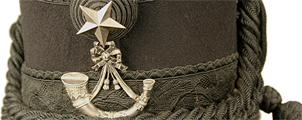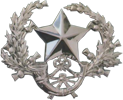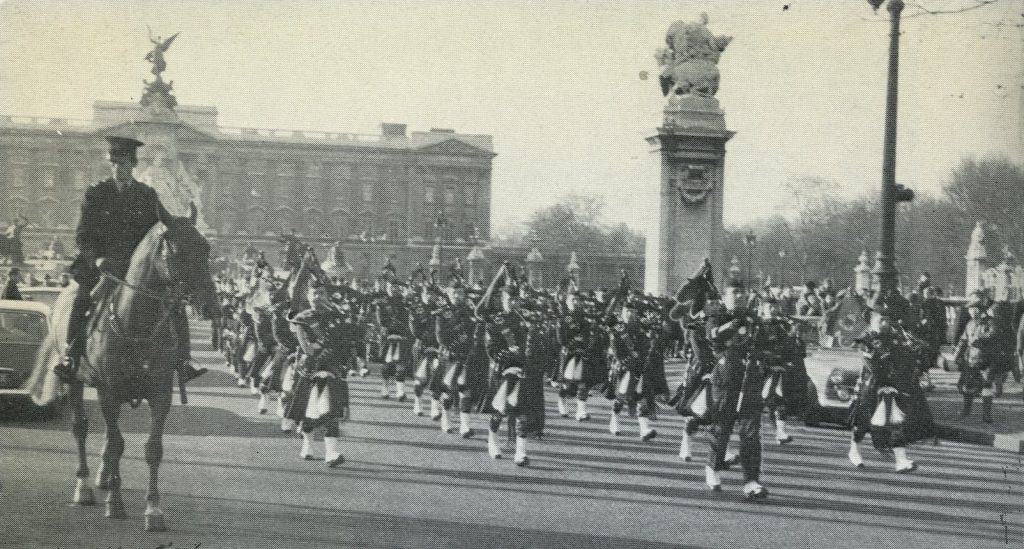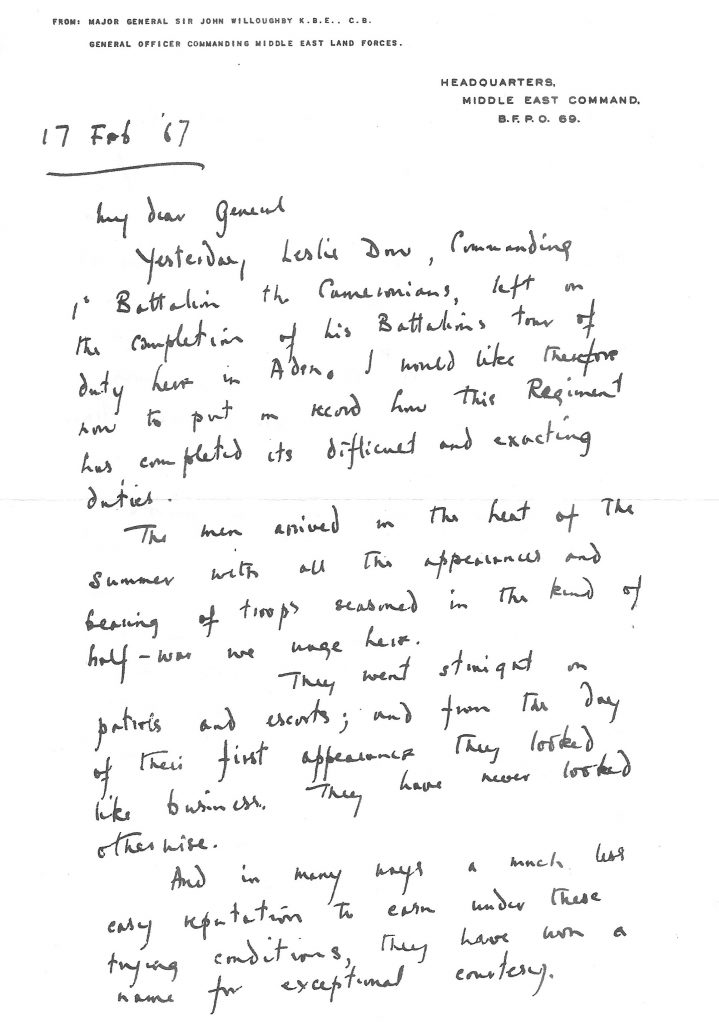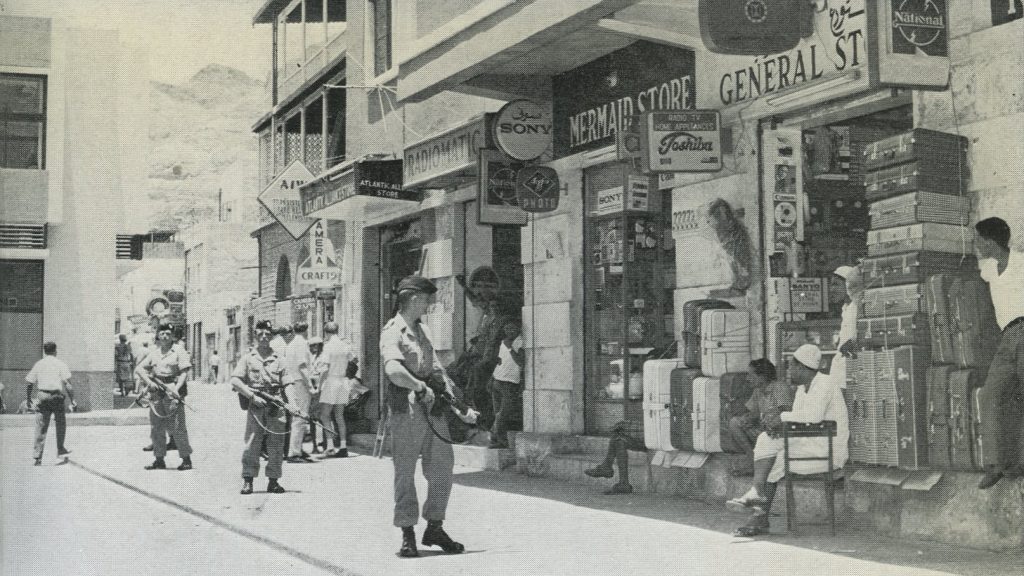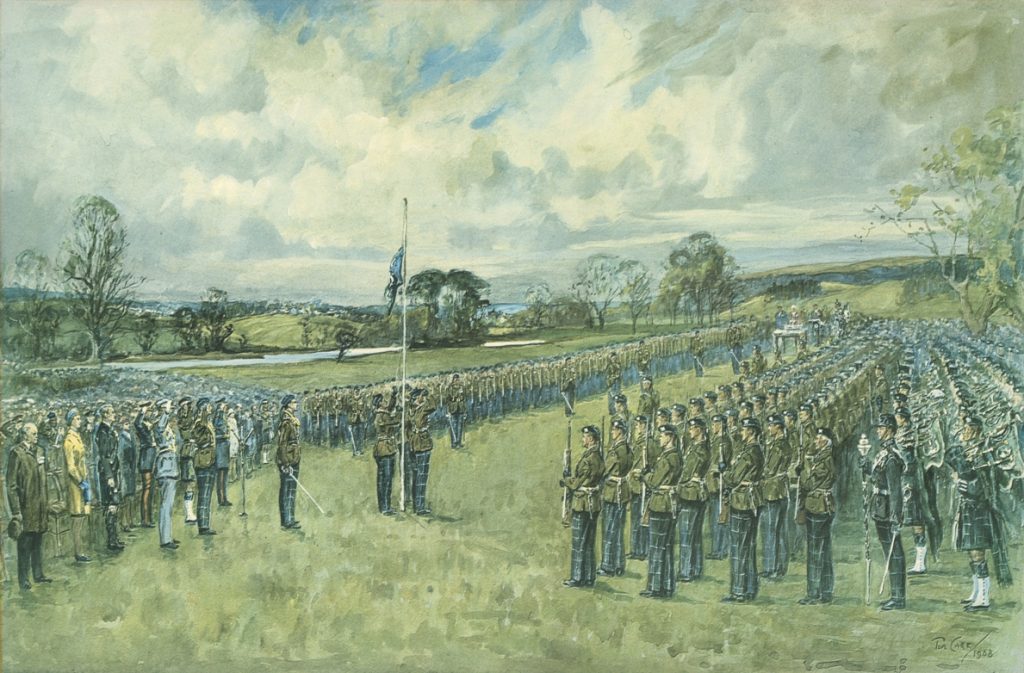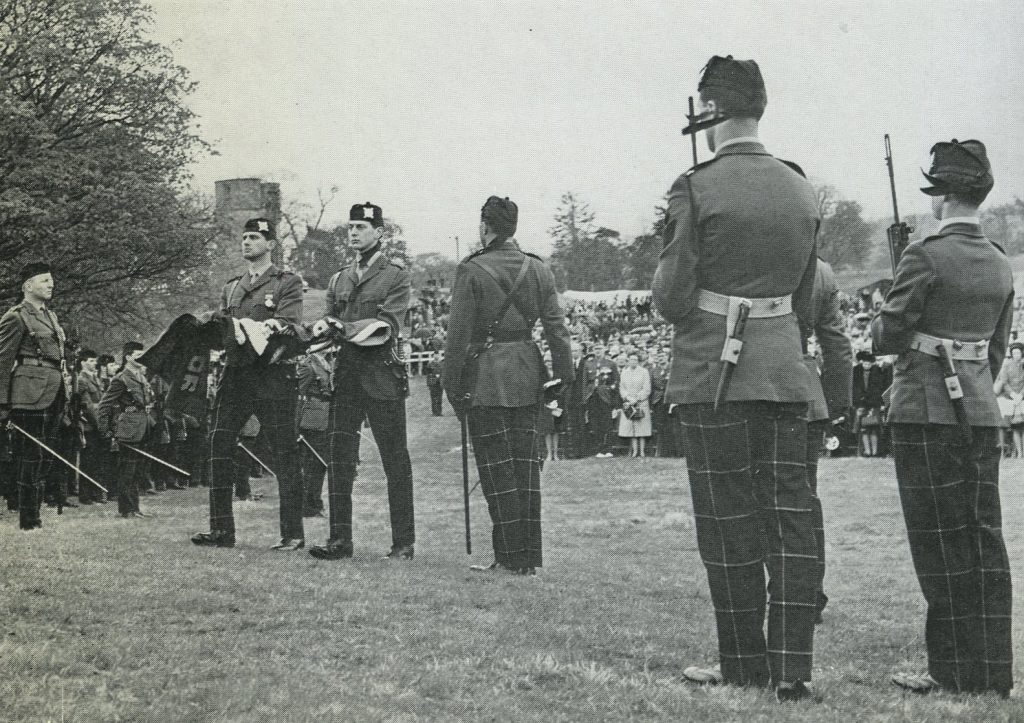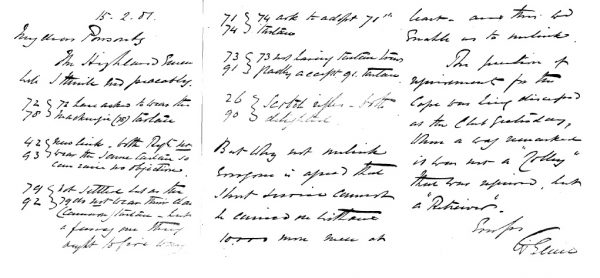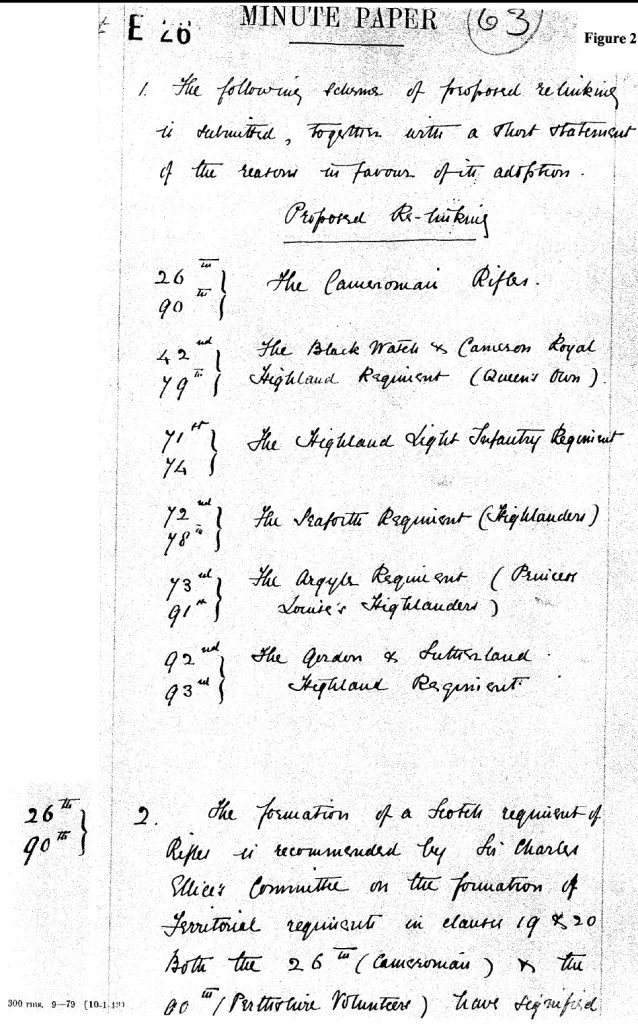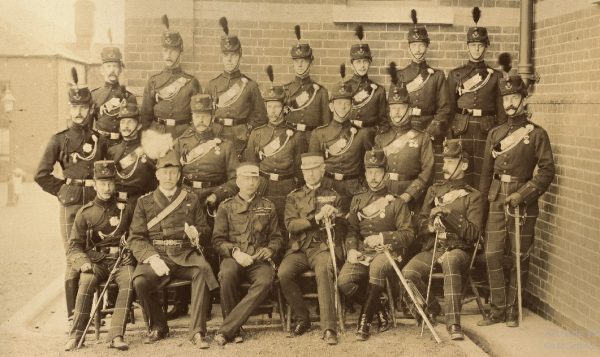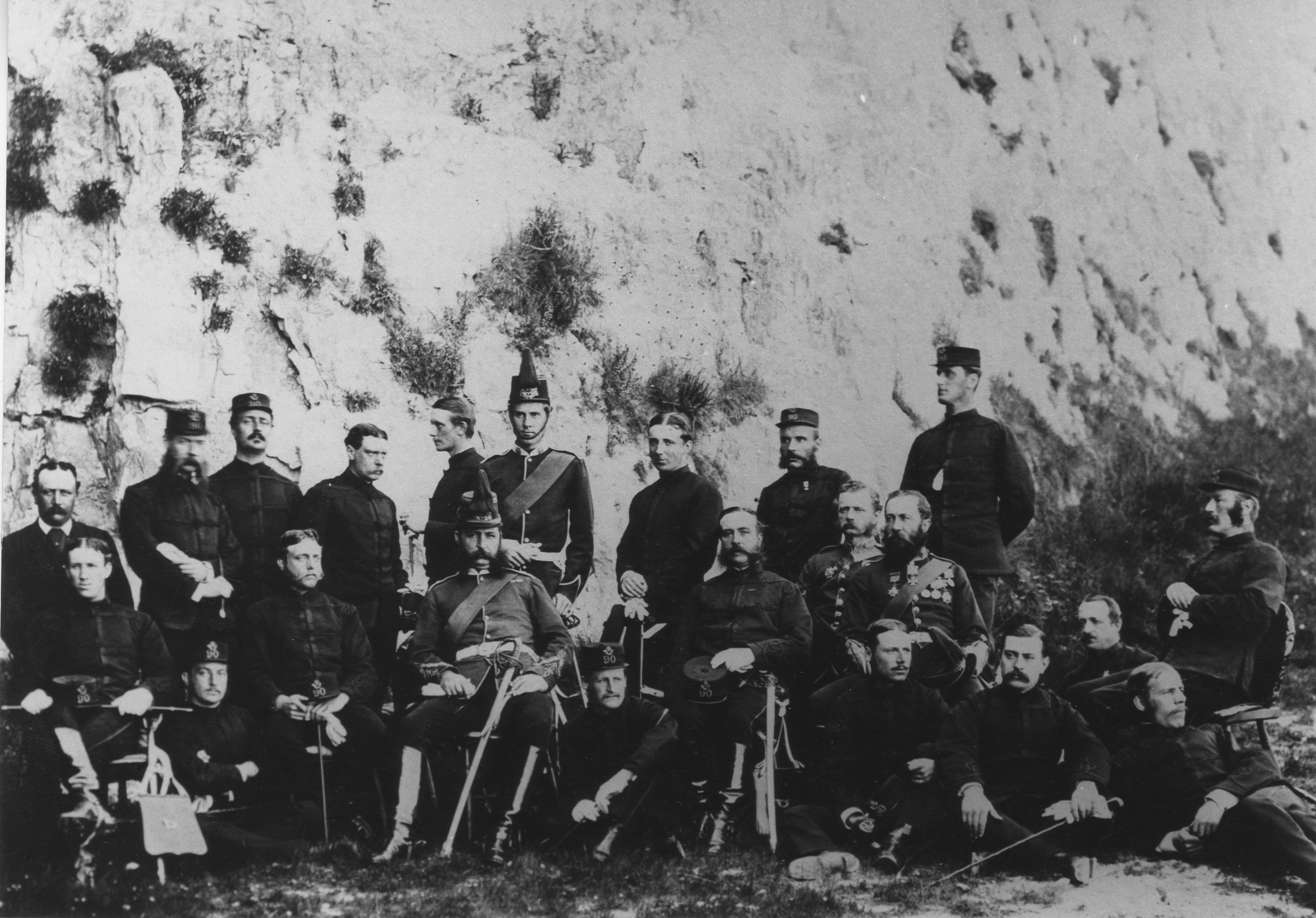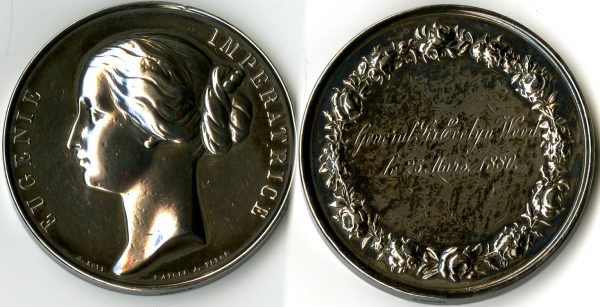The Cameronian Generals
by Philip R Grant
First Published with the 2005 Covenanter – Regimental Journal of The Cameronians (Scottish Rifles)
[Revised 2007, 2009 and 2021]
“We have to go now, sir: it’s time for us to go.” With these words Lieutenant Colonel Leslie Dow asked for permission to dismiss and to march off parade the 1st Battalion The Cameronians (Scottish Rifles). But it was a dismissal like no other. It was to be forever.
It was 14 May 1968 and 279 years to the day after their formation, on the same spot in Douglas Dale. The Cameronians (Scottish Rifles) were marching off into the pages of history. For an old and proud regiment it was a dire day. The tight-jawed faces of the soldiers said it all. The Cameronians were in the business of obeying orders, no matter how hard or how disagreeable. The order to disband was one of the hardest and most disagreeable that most could imagine. It was also the most unjust.
Almost to a man those who paraded that day had been with the 1st Battalion when, only months earlier, they had returned from an outstandingly successful tour on active service in South Arabia. Not for nothing did they march to that stirring pipe tune The Barren Rocks of Aden. There they had borne not just the heat and burden of the day but had taken on the chin an average of one gun or grenade attack every two or three days (102 in nine months)[1]. The day after they left, the GOC Middle East Land Forces, Major General Sir John Willoughby, wrote from his headquarters in Aden to the Chief of the General Staff in London:
My Dear General,
… The men arrived in the heat of the summer with all the appearances and bearing of troops seasoned in the kind of half-war we wage here.
They went straight on patrols and escorts; and from the day of their first appearance they looked like business. They have never looked otherwise.
And in many ways a much less easy reputation to earn under these trying conditions, they have won a name for exceptional courtesy.
They will ever be remembered by the families of Servicemen and of Civilians with affection, not only for these qualities but in the crowning of their association with their Pipes in the open streets. And in the telling of this day by the ordinary wives of ordinary families bearing the strains of terrorism magnificently, I have seen tears of gratitude and of pride.
They are second to none, and I am as proud of having these men under my Command as they have reason to be of their record and reputation so well and truly earned in Aden, and in the hills of Southern Arabia.
Yours very sincerely,
John[2]
Every member of the Battalion had seen a copy of the letter, and the letter sent subsequently by the Chief of the General Staff, General Sir James Cassels, to the Colonel of the Regiment. In it CGS wrote:
… I saw your Battalion in Aden in January [1967], and everywhere I went there was nothing but praise for the way the men had behaved and acted. …[3]
Of this exchange of letters Volume IV of The History of The Cameronians[4] says: ‘It was unique for letters of this nature to be written about any battalion …’. So why were they marching off into history, to be dispersed amongst almost every branch of the army?
Defence cuts and reorganisations are nothing new. The whole regimental structure which endured both World Wars was based on the Cardwell reforms of the 1870’s and ‘80’s when the primary requirement was to service the needs of Empire. On that basis a regimental system of two battalions per regiment was established. In broad terms one battalion then served at home whilst the other spent anything up to ten years in India or one of the colonies. After World War II the necessary reductions were achieved by disbanding (or placing into ‘suspended animation’) one battalion of each infantry regiment. In the case of the Cameronians the 1st Battalion, which had been decimated time after time in the Far East, was folded into the 2nd which was re-designated the 1st Battalion. Commenting on the ‘new’ 1st Battalion, a senior officer was heard in the corridors of the War Office to the effect that … ‘if anyone wished to see how an infantry battalion should be run he ought to go out to Gibraltar and see the Cameronians[5]. That chimes well with the comments of twenty years later.
In the mid-1950’s still further reductions were sought continuing a process which was still going on fifty years later. In the 1957 round there were some major amalgamations such as the Camerons and Seaforths to form the Queen’s Own Highlanders. (Since then the Gordons too have been culled and their name joined with the Camerons and Seaforths in The Highlanders.) The amalgamation which caused a huge rumpus was the so-called ‘trews versus kilts’ one which, from the Royal Scots Fusiliers and the Highland Light Infantry created the Royal Highland Fusiliers.
In 1966 yet another round of reductions was mooted and the result was announced in parliament on 18 July 1967:
Lowland Brigade. The brigade will reduce by one battalion, which is to be the 1st Battalion The Cameronians (Scottish Rifles). The Council of [Scottish] Colonels did not recommend an amalgamation with another battalion in the event of reduction.[6]
The original requirement was that the Battalion disband ‘by 1970’ but, as that would have meant mouldering in Scotland for two years with no proper soldierly role, it was decided that nothing was to be gained by simply delaying the awful day. It seemed obvious: 14th May should be the date and Douglas the place.
Taking part on the day was a great company of past and present members of the Regiment. Of course it was the 1st Battalion which had pride of place – it was they after all who were disbanding – but there were also many others too. There were the regular officers and men of the 1st Battalion who were ERE (Extra-Regimentally Employed). By far the largest contingent though comprised former members of the Regiment, the ‘Old and Bold’ of all battalions. If the Glengarries on the younger heads of the 1st Battalion were held high, they were held no higher than the heads with grey, white or very little hair of those who proudly took part in the march past. But what distinguished this latter body of men was the group – some say a unique group – which led them. Instead of Glengarries they wore top hats, and morning suits with honours and medals. They were The Generals.

with Lieutenant General Evetts (rear left)
at the 1st Battalion’s disbandment at Douglas, 14 May 1968
South Lanarkshire Council collection
It has long been the view in regimental circles that the number and distinction of these Generals made the Regiment unique. Subject to evidence to the contrary it continues to be the view of the writer, and of others then and now, that it was indeed unheard of that one infantry regiment of just two regular battalions should produce such a rich crop of senior officers.
But what is a ‘Cameronian General’? At first sight an odd question but one which must be addressed. Clearly it would not cover someone who had been transferred for a period to one of the battalions in wartime. The definition used here covers an officer who:
- was commissioned into the Regiment
- transferred to the Regiment
- finished his regimental service with the Regiment
- ensured that his name (and up-to-date address) appeared in the regularly published list of Retired Officers of the Regiment, and, as a catch-all, an officer who
- considered himself to be a Cameronian for any or all of the above reasons.
Brigadier C N Barclay CBE DSO, author of Volume III of the Regimental History, wrote in 1947[7]:
The Author has made a very exhaustive search of records and has come to the conclusion that there is no Infantry Regiment which produced so many high Commanders and Senior Staff Officers in World War II as The Cameronians.
He then goes on to list two Generals, two Lieutenant Generals, five Major Generals and no fewer than nineteen Brigadiers (of whom he, Barclay, was one). While some of them did not survive until 1968 or were unable to travel to the Disbandment, most of them did, and indeed some had been promoted in the interim. Although consideration is being given here only to those alive in 1968, it is clear that the number and distinction of these Generals, the subject of this article, is very much dependent on and a product of Barclay’s 1947 list.
Who were they, what circumstances had brought them to high rank, what had they in common? What contribution had the Regiment made to their success? These are the questions which we will now attempt to answer.
The two regular battalions of The Cameronians (Scottish Rifles) were formed by the amalgamation in 1881 of two regiments. The 1st Battalion was the old 26th of Foot, The Cameronians. The 2nd Battalion was the old 90th, The Perthshire Light Infantry. At first sight these seemed two very different entities but the amalgamation to form Scotland’s own and unique Rifle Regiment was ultimately most successful. It was the opportunity to take the best of both and to forge something even better. It was the opposite of what was always a hazard in later amalgamations when the component parts reluctantly gave up bits of each in an endeavour to find at least some common ground. It was the unique nature of the Scottish Rifles which meant that, when the time came barely 80 years later for reductions instead of expansion, a dignified disbandment was the only real option.[8] Given the wholesale and radical changes carried through most recently – 2006 – that decision can be seen as not just the right one then, but enlightened.
Historically there was always a tradition of very senior officers being produced by or associated with the Regiment, though in truth, up to 1881, this was based almost entirely on the 90th. They had the distinction of producing no fewer than two Commanders-in-Chief of the army and two Field Marshals – Sir Garnet Wolseley was both. Their founder was himself one of the most distinguished. He was General Sir Thomas Graham of Balgowan, who later became Lord Lynedoch and was the Duke of Wellington’s ablest commander.[9] Others were:
- General Sir Rowland (later Lord) Hill[10], like Graham, ennobled for his leadership in the Peninsular war.
- Field Marshal Sir Evelyn Wood VC who also became Acting Commander-in-Chief. He was, incidentally, one of seven officers of the 90th who took part in a ceremony of Laying-Up of Colours in Perth in 1872. Of the seven, three wore the Victoria Cross.
Another distinction which the 90th had: three VC’s were to command the Regiment.
Lest it seem that the military virtues were a bit one-sided or that the 90th were marrying a bit beneath themselves, the sheen and shimmer of the 90th should be seen against the deep lustre of the 26th. Not only had they 200 years of distinguished service to the Crown – everywhere from Marlborough’s Blenheim to Napier’s epic campaign in Abyssinia – they had also earned themselves an impressive record in the soldierly skill of rifle shooting. In the Army in India they came 3rd in 1873 and 1st the following year. Back on home service they competed in the Army Championships at Bisley, coming 3rd in 1876 and 1st in ‘77. Indeed the Regimental History (Volume I)[11] goes so far as to suggest: ‘Perhaps its success in marksmanship … was responsible for this decision [to name the new regiment The Scottish Rifles and to make the 26th the 1st Battalion]’. They were also the senior regiment with only one battalion
At a time when the variety and flamboyance of uniforms was unsurpassed it would also add to the impact of large parades: a foil for all that scarlet and gold. Pictures of the celebration of Queen Victoria’s Diamond Jubilee confirm this vividly.
It is also worth noting in passing that this expertise in marksmanship was maintained long after the amalgamation. The 1st Battalion (the old 26th) came 1st in the Army Championships again in 1886, and the next year ‘won all of the major championships’ (ibid Volume I). It won the Inter-Regimental Competition in 1890. In 1893 it took both 1st and 2nd prize in the Evelyn Wood Competition at Bisley, and in 1894 Private Brown[12] won the Imperial Prize open to all ranks of the regular army. That the old 26th did so well in a competition named after an outstanding product of the old 90th is a testimony to both halves of the Regiment.
The marriage though ultimately highly successful took some time to gel. In a marriage of strong characters, and especially between those who have enjoyed independence for an extended period, there were bound to be differences. The History records that:
Prior to World War I, The Cameronians (Scottish Rifles) were not highly organised on a Regimental basis. The two Regular Battalions adopted a somewhat parochial attitude. Members of the 1st Battalion liked to be called ‘Cameronians’, those of the 2nd Battalion ‘Scottish Rifles’. There were minor differences in dress, and long serving personnel – both Officers and men – tended to remain with one Battalion throughout their careers. Transfer from the 1st to the 2nd Battalion, or vice versa, was a matter for regret, if not actual resentment.[13]
None of that is surprising especially as the concept of amalgamations was a new one and the two halves of the Regiment never served together anyway, indeed the whole structure was designed on the basis that they would not. There is nothing wrong with rivalry, indeed that and competition are often factors which bring out the best in individuals and organisations. But we deal now with a period when these feelings were long in the past.
Although the Colonel of the Regiment rightly headed the 1968 March Past of the ‘Old and Bold’, it is right to list The Generals in their order of seniority. They were:
General Sir Thomas Riddell-Webster
General Sir Richard O’Connor
General Sir Horatius Murray
Lieutenant General Sir John Evetts
Lieutenant General Sir Alexander Galloway
Lieutenant General Sir George Collingwood Colonel of The Regiment
Major General Robin Money
Major General Douglas Graham
Major General Eric Sixsmith
Major General John Frost
Major General Henry Alexander
Additionally we should remember Major General Norris Haugh who was sick and who sent his no doubt heart-felt apologies. There is one other too whom I have kept in the list: General Sir Roy Bucher. He did not join the parade nor is there any record of his having been there. It must be assumed that he was prevented from doing so by infirmity or incapacity.
That is an impressive list but it tells only part of the story. Without counting the Brigadiers (who we will come to later) and except for those who were promoted, here they are:
| 1947 | 1968 | |||||||
| Generals (****) | 2 | 4 | ||||||
| Lieutenant Generals (***) | 5 | 3 | ||||||
| Major Generals (**) | 5 | 6 | ||||||
| [24] | [37] |
In trying to make some sort of a comparison, no matter how inadequate a measure it is, I have added on the bottom line [ ] what might be called a star count using the traditional (though originally American) general officers’ insignias as above. Using this crude star count the 1968 measure is more than 50% above what was recorded in 1947. If Barclay thought that the 1947 number was unique then it seems incontrovertible that the 1968 list was equally so, irrespective of the number of Brigadiers.
My reason for including Bucher (though Barclay did not) is simple: he fulfils the criteria above. More than that, and what finally tipped the balance, he is included by General Murray in a memoir he wrote in which he refers to the ‘thirteen generals’[14]. Moreover that is the number quoted by The Times in their obituary of Lieutenant General Evetts. Of course some of the names on the list changed either through promotion or through death.
But now we must confine ourselves to the generals of 1968, most of whom came together on parade almost certainly for the first and for the last time, and to the two who would have given so much to have been there if they could. In trying to establish what brought all of these generals together in one regiment we must start by looking at a necessarily brief summary of their lives.
The following sketchy pen pictures cannot really begin to do justice to their subjects. In two cases there are full, published, biographies to draw on but for the majority other sources have had to be relied on. Regrettably almost all of these sources are secondary. As this gallery of greatness is of interest as much as a collection as for its individual subjects, this is perhaps less serious than if it were an in-depth study of each figure. That said, and considering the inevitably limited size of the canvases, it is hoped that there is enough colour on the writer’s palette to allow them to emerge from the shadows. So, let us now enter the first room marked ‘General’.
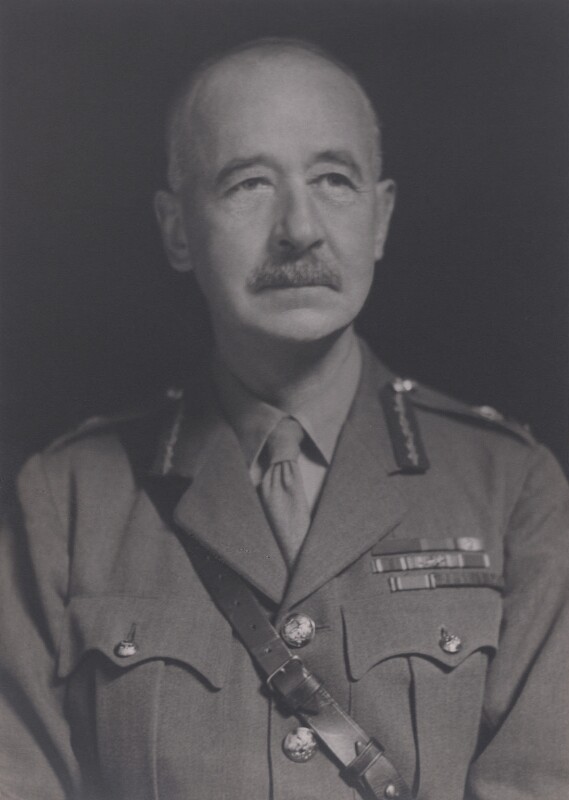
by Walter Stoneman
bromide print, September 1942
NPG x164434
© National Portrait Gallery, London
General Sir Thomas Riddell-Webster GCB DSO DL spent most of World War II at the War Office. He was Quartermaster General 1942-1946. Before that as a Major General he was Director-General Movements and Quartering (1938-1939) and Deputy Quartermaster General (1939-1940). In between these appointments he was Lieutenant General of Administration Middle East (1941-1942) with a brief period in 1941 as GOC-in-C Southern India. So as either Deputy or Quartermaster General he bore huge responsibilities during the pivotal events of Dunkirk, the North African offensive, the invasion of Italy and for D-Day and beyond, not to mention the awesome planning necessary at the end of the war, the occupation of defeated Europe, and the return to peacetime. On his retirement in 1946 his career was capped with his appointment as Colonel of the Regiment 1946-1951.
Riddell-Webster was born in 1886, went to school at Harrow and then to the RMC Sandhurst. He was commissioned into The Cameronians (Scottish Rifles) in 1905. Promotion came slowly in those days. By 1914 he was the junior Captain in the Regiment and still a Captain in 1918 though holding the brevet rank of Major. Much of his war was spent as a staff officer in France and in Italy. He was awarded the DSO as well as the French and Belgian Croix de Guerre. It was during the inter-war years that he rose steadily. After Staff College he commanded a company of the 1st Battalion as a Major (Brevet Lt Col) and then in 1930 he took command of the 2nd Battalion. He commanded a brigade in India 1933-1936 and by 1938 he had reached the rank of Major General.
Writing in The Covenanter Brigadier CN Barclay said[15]:
It is usual, although not invariable, for officers who attain high rank to have a penchant for either command or the staff side of soldiering. General Riddell-Webster was not among them: he was at home in either – whether it was commanding a Company, Battalion or Brigade …; or directing the dispersal of troops arriving from Dunkirk or dealing with the vast administrative problems as QMG in a national war. … Any duty requiring organizing ability – running a Weapons or Sports meeting, chairing a led discussion whether as a comparatively junior or senior officer – came easily to him. His bent in this direction greatly helped him at the Staff College (as student and later as a member of the Directing Staff) and later still at the Imperial Defence College.
Barclay then goes on:
He was an enthusiastic sportsman. A fine rider to hounds and a keen contestant in point-to-point races …; a useful golfer and, in his younger days, always ready to try his hand at any other sport or game …. [He was also a fine shot.]
During the time he commanded the 2nd Battalion in Glasgow he hunted regularly and in this connection it is worth mentioning two of his companions. He encouraged his young officers to hunt with him and in this regard reference is to be found to the best horseman the Regiment ever had, Major General Henry Alexander, who was then a subaltern. But another with whom he hunted regularly with the Eglinton was Brigadier General James Jack (of whom more later as well). Bearing in mind that Jack had joined the Regiment ten years before Riddell-Webster this represented almost three ‘generations’ of the officer corps.
Barclay sums up the man – the General:
Although he had very definite opinions on most subjects he was always ready to hear a different view; after hearing it he would state his own case in no uncertain manner, and he was nearly always right.
He died in 1974 aged 88.
***
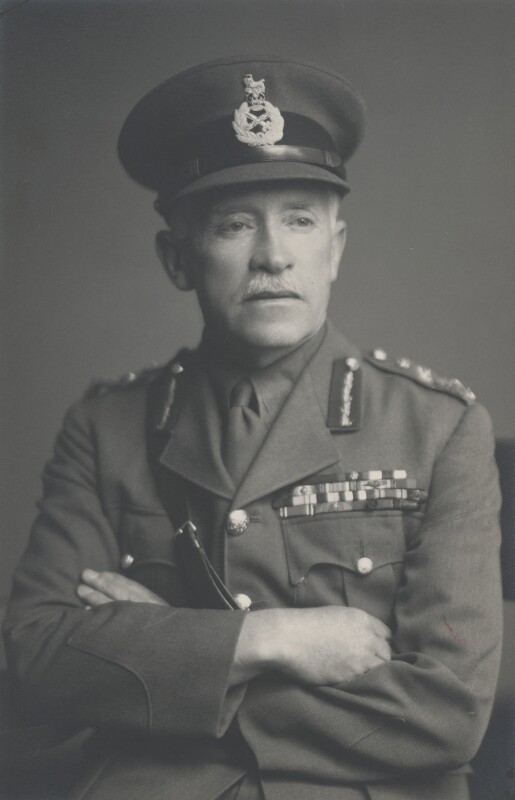
by Walter Stoneman
bromide print, 1946
NPG x186912
© National Portrait Gallery, London
General Sir Richard O’Connor KT GCB DSO*[16] MC was described in his obituary in The Covenanter[17] as ‘unquestionably the Regiment’s most distinguished soldier of his generation’. His crowning achievement was his defeat of the Italian 14th Army in 1941. Who knows what else he might have achieved had he not then spent the next three years as a prisoner of war.
He was born in 1889. After school at Wellington College he went to RMC Sandhurst and from there he was commissioned into the Regiment, joining the 2nd Battalion in 1909. (For this and for much else which follows we are indebted to his excellent biography, The Forgotten Victor by Lt Col Sir John Baynes.[18]) The following ten years, formative for any young man, were to shape him and his career. His obituary in The Times said (in part)[19]:
O’Connor’s record in the First World War was remarkable. He was mentioned in despatches nine times [it was seven, another two were added in WWII], was awarded the DSO and bar, the Military Cross, and the Italian Silver Medal for bravery …. He was 25 years of age when the war broke out and he was in the thick of the fighting on the Western Front practically without a break. As a company commander and adjutant he became a legend in his own regiment. He was Brigade Major of [two] Brigades; and he created a precedent when he commanded the 2nd/1st Battalion of the Honourable Artillery Company … for it is a three centuries old tradition in the HAC that their units should be commanded by one of their own….
18 years after the end of the First World War, O’Connor was still only a major in his regiment …. After 1936 promotion came to him quickly. He was selected … to command the 1st Battalion … but before he could take up the appointment he was posted … as Commander of the Pershawar Brigade … a coveted command. After two years on active service on the [North West] Frontier, O’Connor was promoted Major General and went to Palestine in command of the 7th Division.
In 1920 he had attended the Staff College (to which he was to return as an instructor) In 1924 he was to transfer to the 1st Battalion, once more in the post as Adjutant, and during a most important era which will be referred to later in detail.
As a young man Baynes says O’Connor was ‘a very keen rider with a reputation for boldness in the hunting field and on the point-to-point course’.
Come 1940 he was in Egypt in the rank of Lieutenant General and given command of a force of some 30,000 troops. With them he destroyed the Italian army in the first Libyan campaign. They ‘advanced 500 miles in eight weeks, taking 130,000 prisoners, 400 tanks and 1,200 guns’ (ibid). It was pure misfortune that he was to be captured in early 1941. He spent the next three years incarcerated in Italy until his second and successful attempt to escape. By June 1944 he was in the field again in command of VIII Corps in Normandy but although he gave the impression to many that he was unaffected by his three years in captivity, there was in some minds a lingering doubt as to whether, as Baynes puts it, ‘he lacked some of his original fire and confidence’. Perhaps he had aged more than others and, at 55, he was in any case ‘old for the wartime command of a corps’ (ibid).
By the end of the year, after a fully successful but perhaps lacklustre period in Europe (when his ‘scope for original action was very limited’ – ibid) he was asked to go to India as GOC-in-C Eastern Army. In a personal letter Montgomery (his old contemporary at Staff College) wrote: ‘You will be a great loss here. But you are needed in India.’ Though it was not an operational command its importance was undoubted and the high esteem in which he was held was underlined by his promotion to the rank of General. With the end of the war his district had ceased to be the most important and he was moved to take over the huge combined Northern and Western Army. By early 1946 Montgomery (who was taking over as CIGS) asked him to return to London to the Army Board, originally in the post of Military Secretary but ultimately to the even more important job of Adjutant General, described to him by his old friend Field Marshal Viscount Wavell as ‘… the most important job in the Army at the present time’. He was joining the Army Board just as Riddell-Webster was leaving it.
Of this period Baynes wrote:
… his personality was not entirely suited to his appointment. Like many great soldiers he was politically unsophisticated, and his simple outlook and shining integrity were often a handicap when fighting his corner amidst the intrigues of Whitehall. While he had enjoyed his three years at the War Office … [as a Major] 1932 to 1935, his return at an exalted rank eleven years later did not bring him the same happiness…[20]
In 1951 he succeeded Riddell-Webster as Colonel of The Cameronians (Scottish Rifles). In 1964 he was appointed by the Queen to be her Lord High Commissioner to the General Assembly of the Church of Scotland. In 1971 Her Majesty appointed him one of the sixteen Knights of the Thistle, an honour second only to that of the Garter though its numbers are smaller and so, perhaps, even more select.
Of his character much has been written. The Times:
He had a quiet, retiring, almost shy manner, but could sometimes be alarmingly direct in thought and speech.
When both were elderly and long retired Murray was to write to him: ‘Whether you are prepared to accept it or not, the fact remains that [when you arrived back as Adjutant in 1924] you were a somewhat frightening person. We were all told about the officer of the HAC who had fainted while being dealt with by you.’[21]
The Sunday Times in an article entitled: ‘The Lost Leader’ of the Desert War[22]:
Despite his self-effacing and diffident manner, he had a subtle magnetism. Small[23] and neat as a bird, he was, in the words of a colleague, “always springy and alert, even when still – always vibrant and alive”.
Honoured by Queen and country, revered in military circles, he died in 1981 at the age of 91.
***
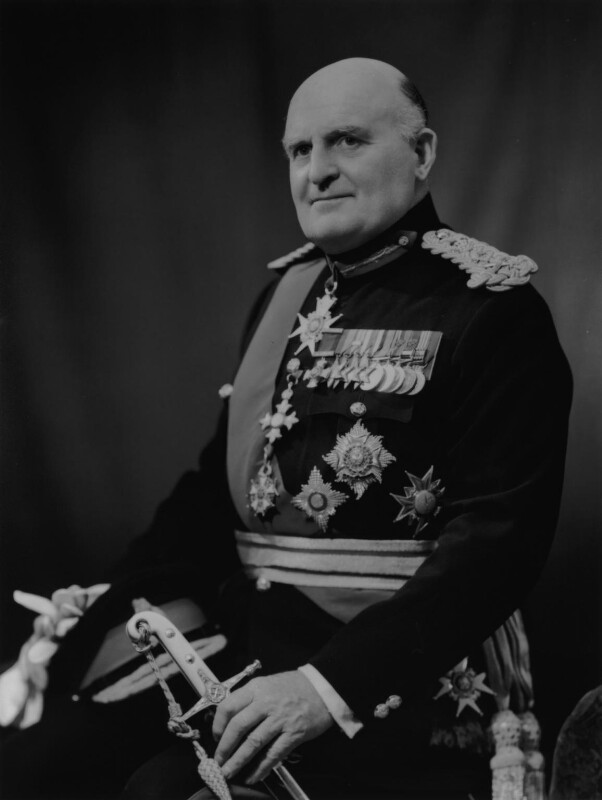
by Bassano Ltd
half-plate film negative, 18 March 1963
NPG x175418
© National Portrait Gallery, London
General Sir Horatius Murray GCB KBE DSO was born in 1903, went to Peter Symonds’ School, Winchester, and from there to the RMC Sandhurst. In 1923 he was commissioned into The Cameronians (Scottish Rifles) with whom he served almost continuously until going to Staff College in 1936. As mentioned earlier, this was a pivotal time in the Regiment and he had a thorough grounding from officers who had distinguished themselves in World War I. His talents were spotted early. Whilst still a subaltern he was Adjutant of the 1st Battalion and held the post for the unusually long period of three years.
Early on he was nicknamed ‘Nap’ (short for Napoleon) because of his dedication to his profession, which must have been remarkable in a regiment where a high level of professionalism was far from unusual. He was a good soccer player and he represented both the RMC Sandhurst and the Army Crusaders as a formidable goalkeeper.
In 1942 he was selected to command the 1st Battalion Gordon Highlanders which he led at the battles of Alam Halfa and El Alamein. Having been wounded at the latter he spent six months in hospital from which he discharged himself, and shortly afterwards was given command of 153 Infantry Brigade (51st Highland Division)[24] which he led in Tunisia and Sicily. He later went on to lead them in the Normandy campaign. Soon he was promoted to take over command of 6th Armoured Division from the then incumbent, the future Field Marshal Sir Gerald Templer. As ‘Nap’s’ obituary in the Daily Telegraph said[25]:
It was not unknown for an infantryman to command an armoured division … but Murray’s performance in the gruelling Northern Apennines winter and later in the Po Valley was exceptional by any standards. Not only did he show a grasp of the intricacies of armoured warfare but also paid so much attention to the morale and welfare of the division that it was able to outfight and outlast the resourceful and skilful German troops who confronted it. …
Having qualified as an interpreter he [had] served with a German regiment on an officer-exchange, an experience which proved of great value understanding German military psychology later.
His obituary in The Covenanter adds[26]:
In the decisive action in the Po Valley in 1945 his division broke out of the Argenta Gap and sliced through the German rear echelons, encircling and destroying the bulk of the German forces. Quite a feat!
At the end of the Italian Campaign he accepted the German surrender on the Austrian border and was faced with the distasteful task of repatriating thousands of Russians who had been serving with the German army. He had no alternative but to obey orders but he delayed handing them over to the Red Army long enough to allow many to escape.
At this time he briefly commanded XIII Corps in the rank of Lieutenant General.
At heart he was always an infantryman. After a short spell at the War Office, which he did not enjoy (pace O’Connor), he was successively GOC 1st Division in Palestine, 1948-1949, GOC Northumbrian District, and then, 1953-1954, GOC the Commonwealth Division in Korea. Once more a Lieutenant General, he was from 1955 to 1958 GOC Scotland and Governor of Edinburgh Castle. Promoted again, his final command was in NATO, 1958-1961, as C-in-C Allied Forces, Northern Europe with his headquarters in Oslo. He was Colonel of The Cameronians (Scottish Rifles) 1958 to 1963.
Of his character the Daily Telegraph said:
Dignified in appearance, Murray appeared somewhat aloof on first acquaintance but had a warm personality and a special ability at getting on with the younger generation; his tolerance of long hair and other foibles of junior officers surprised many but typified his understanding of what was important and what was not.
He wrote a short but important memoir published in The Covenanter in 1972 and entitled A Gaggle of Generals. This will be referred to and quoted at length later.
[The writer was commissioned into the Cameronians during General Murray’s colonelcy.]
He died in 1989 at the age of 86.
***
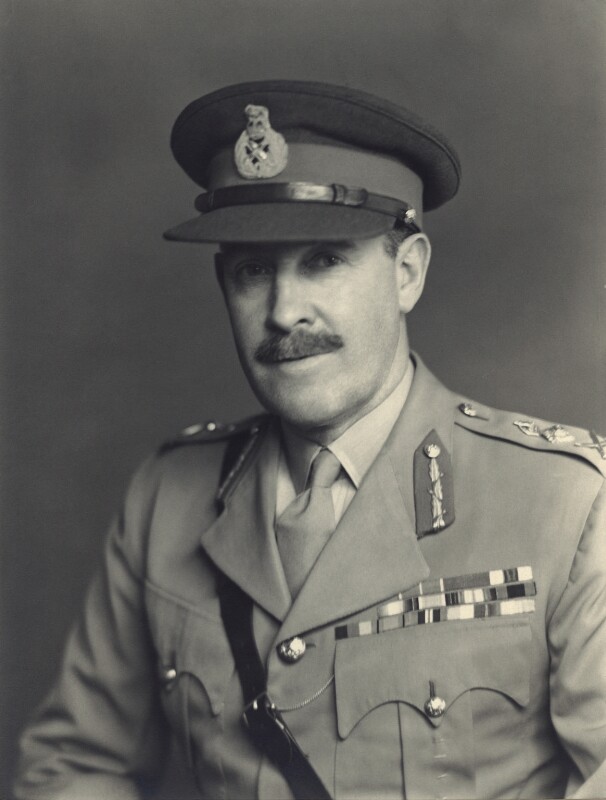
by Walter Stoneman
bromide print, September 1949
NPG x166214
© National Portrait Gallery, London
General Sir Roy Bucher KBE CB MC DL There is a case for including this distinguished officer based on the criteria above, though his service with the Regiment was cut short when he was wounded. He was commissioned into the Regiment in France at the start of World War I and in 1915 was wounded at Givenchy.
He was born in 1895 and educated at Edinburgh Academy. Following his introduction to regimental life and to action in the trenches he was, like so many, a casualty. After that and for much of his life his soldiering was to be in India. He attended Staff College in 1927 where O’Connor was one of the Directing Staff (instructors).
From early on most of his career was spent with the cavalry. Up to the outbreak of World War II he was in command of the 13th / 18th Royal Hussars[27]. He also commanded Sam Browne’s Cavalry. Of them it has been said that, “They were very grand and very picky”. From there he rose steadily filling both command and staff posts. In 1946 he became C-in-C Eastern Command (India) where he succeeded O’Connor. So successful was he that he became the last British Commander-in-Chief of the Indian Army a post that would have given him command of numbers far in excess of any but a very few generals in either world war.
Anyone who has had the privilege of serving knows that the early years shape much of an officer’s later career, not to mention his character. No doubt this is why Bucher chose to remain on the list of Retired Officers which was published regularly in The Covenanter. If he considered himself a Cameronian then that surely is sufficient reason to include him with so many of his distinguished contemporaries.
He died in 1980 at the age of 84.
***
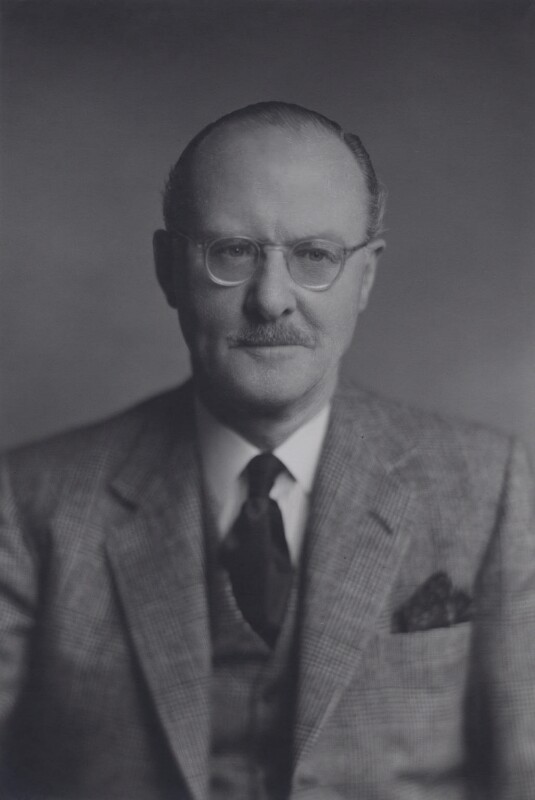
by Walter Stoneman
bromide print, 1955
NPG x167458
© National Portrait Gallery, London
Lieutenant General Sir John Evetts CB CBE MC was born in 1891 and after school at Lancing College went to the RMC Sandhurst from where he was gazetted in The Cameronians (Scottish Rifles) in 1911. He served most of World War I in France being wounded several times and awarded the MC. He was later to go on to be a highly successful commander, but his greatest contribution was as a staff officer and administrator. The Times said of him[28]:
… he was given command of the 1st Battalion Royal Ulster Rifles in Egypt. What would have been a normal tour in command was interrupted by the outbreak of the Arab rebellion in Palestine where Evetts commanded 16 Infantry Brigade from 1936 to 1939. He proved himself to be a resourceful and inspiring commander of troops and was appointed CBE for his services in 1937, and CB in 1939.
Evetts was serving in India when war broke out in 1939. He commanded Western (Independent) District in 1940 before moving to the Middle East where he was appointed GOC 6th Division. He led his division successfully during the brief campaign in Syria in 1941 but soon thereafter returned home to assume the onerous appointment of ACIGS* [in the rank of Lieutenant General] in the War Office with special responsibility for Weapons Procurement. *Assistant Chief of the Imperial General Staff
This was a vitally important if unglamorous appointment which Evetts discharged to the best of his considerable ability. Indeed much of the credit for equipping the British Army to take part in the Normandy Landings must be his. …The Americans recognised his services by awarding him the Legion of Merit in 1943.
In 1944 he became Senior Military Adviser to the Ministry of Supply and as such was the only military member of its Council, the others being highly qualified scientists. He retired from the Army in 1946. The Times continues:
He then became a senior member of the British team involved in developing and testing nuclear weapons in Australia; he was Head of the Ministry of Supply staff from 1946 to 1951, and Chief Executive of the Joint UK-Australian Long Range Weapons Board of Administration from 1946 to 1949. Evetts was knighted in 1951 and had a successful career in industry from 1951 to 1960.
Evetts [Air] Field on the Woomera Ranges, South Australia, bears his name to this day.
Mention must be made of two written contributions by Evetts. In the early 1920’s, while on the staff of Major General (later General Sir Ivor) Maxse, he co-wrote, with Basil (later Sir Basil) Liddell Hart, the article on Infantry in the 12th Edition of Encyclopaedia Britannica[29]. And while OC the Regimental Depot at Hamilton ten years later wrote a set of Standing Orders for the Regiment of such clarity and concision that although updated from time to time they were never superseded.
Like many of his friends and contemporaries he was a keen sportsman. He was an excellent shot, a good horseman and an enthusiastic polo player, but his principal success was on the cricket field. He turned out for the Free Foresters and Yorkshire Gentlemen. In later life he wrote several letters to the press pointing out how English cricket could be improved.
He died in 1988 at the remarkable age of 97.
***
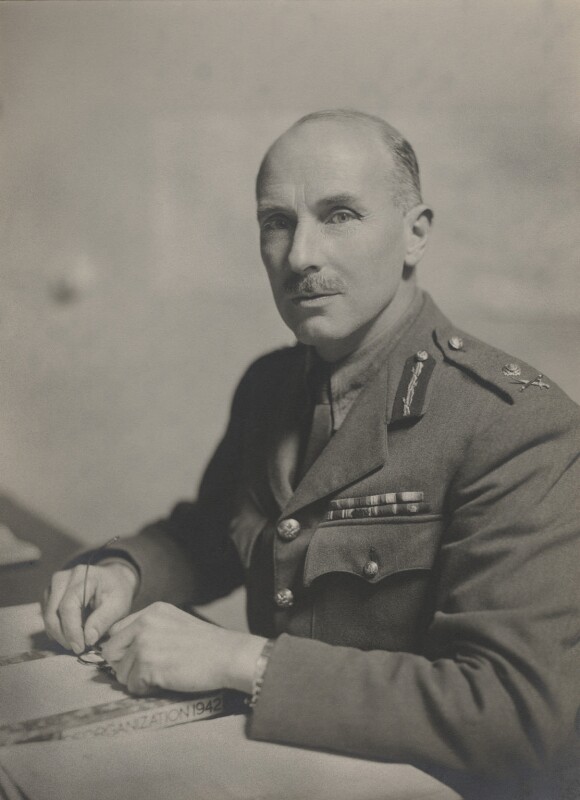
by Walter Stoneman
bromide print, September 1942
NPG x164368
© National Portrait Gallery, London
Lieutenant General Sir Alexander Galloway KBE CB DSO MC. It would be hard to improve on the obituary of him written by Major General Sixsmith which appeared in The Covenanter[30].
In the death of General Galloway the Regiment has lost one of its most distinguished and best loved officers. He was born in 1895 and on the outbreak of the Great War he was just going up to Cambridge. He immediately volunteered for service and was commissioned and went to Gallipoli with 4th Battalion KOSB. He served there to the end of the campaign, coming away in the last ship of the evacuation. He received his regular commission in the Regiment [Cameronians] in 1917 and was awarded the MC for gallantry in action in 1918. After the war he served with the 1st Battalion and became Adjutant in succession to General O’Connor. He left the battalion … to go to Staff College. He was a student there in 1928 and 1929 and returned as an instructor in 1937 and 1938. He assumed command of the 1st Battalion in 1938 and remained … until … 1940 [when he became] Commandant of the Staff College at Haifa.
It was in the Middle East that he showed his outstanding qualities as a fighting soldier. During O’Connor’s victories in the desert, he was Chief Staff Officer (BGS) to General Wilson [GOC British Troops] in Egypt and he went with him in the same appointment when Wilson commanded the ill-fated expedition to Greece. … As in Gallipoli, Galloway was the last off and there were many who testify to the skill with which he organised the evacuation. When, in November 1941, the Eighth Army was organised to drive Rommel out of North Africa, Galloway was appointed as Cunningham’s Chief Staff Officer. [Cunningham was GOC 8th Army.] At first the battle seemed to be going well but Rommel succeeded in defeating each of the three British armoured brigades in detail. With only 30 tanks in running order Cunningham ordered a withdrawal. Galloway saw that such a move would play right into the hands of Rommel and ensure the destruction of the Eighth Army. Torn between loyalty to his Commander and a knowledge of what the battle demanded, Galloway held back the withdrawal orders and personally informed Auchinleck of the situation.
Auchinleck [C-in-C Middle East Command] accepted Galloway’s assessment and came forward himself to command. The situation was restored and Rommel was driven back to the Tripoli border. Auchinleck realised to the full the part Galloway had played in the battle and he was awarded the DSO and mentioned in despatches.
It is the view of the eminent historian, and author of The Desert Generals, Correlli Barnett, that:
Sandy unquestionably saved Operation Crusader from turning into a disastrous defeat, and I have always believed that Auchinleck made a great mistake in pitching Richie from Cairo into (supposedly temporary) command of 8th Army in the middle of a battle, when Sandy would have been the better choice, both in terms of decisive and energetic leadership and of knowledge of the current state of affairs. He would also have averted the disaster of Gazala in 1942.[31]
Sixsmith’s obituary continues:
Galloway was promoted Major General, for a short time used as Deputy Chief of the General Staff in Cairo and as such sent to the United States to select equipment for the Eighth Army. On the way back he was called to the War Office and told he would immediately take up the appointment of Director of Staff Duties there. He was furious. All his hopes were centred on getting command of a division in the forthcoming renewal of the desert battles. For several days he did duty in the War Office dressed in his tropical khaki drill as if to establish the fact that he did not belong there.
Writing of O’Connor’s time on the staff of the Director of Staff Duties (1932-34) Baynes says: ‘Though smaller than the directorates of Operations and Training, that of Staff Duties might be said to have held the reins of power through its control of appointments [including] … the employment of many of the brightest rising stars.’[32]
And a further point: it is recorded that at this time the Minister and strategic planning committee in the Middle East, anxious to inform their counterparts on the Cabinet committee in London, recommended that if anyone wanted to know about desert warfare they should ask Major General Galloway.[33]
Sixsmith again:
The decision was indeed unfortunate for Galloway. After two years in this most important and gruelling War Office job [it was actually just over one year], he was given command of 1st Armoured Division and he returned full of hope to North Africa in the expectation that he would soon be leading his division in battle in Italy. It was not to be: the division was never in action in his time.
He did get another taste of action at the second battle of Cassino. General Tuker, Commander 4th Indian Division, fell ill and Galloway was hurried in to take temporary command, but he acted on somebody else’s plan in an abortive battle and that added to his frustration. Had he been given command of one of the divisions in the Desert war or had he taken his division into battle, there is no doubt he would have gone to the very top. Montgomery knew his worth and used him as his Chief of Staff … while de Guigand was away, and had him as Commander XXX Corps during the occupation [of Germany]. He went on to the important posts of GOC-in-C Malaya in 1946 and was High Commissioner and C-in-C British Troops in Austria 1947-49 [actually 1948-50 and during a time when his own 1st Battalion were under command], but there is no doubt that he felt, and others certainly knew, that this was all less than could have been.
… Sandy was tall, well-built and athletic. He was an exceptionally good golfer and a great cricketer. When he was a student at the Staff College he made a new record for the number of wickets taken in a season. … Sandy had a fiery temper. … In 1925 a subaltern in the Machine Gun Platoon gave him the nickname ‘PR’ which signified ‘Permanent Rage’. But ‘Nap’, adopting Shakespeare, says, “His temper was like summer lightning and left not a mark behind.” He was of a most generous disposition, he had a great sense of humour and he sparkled with enthusiasm.
He died in 1977 at the age of 82.
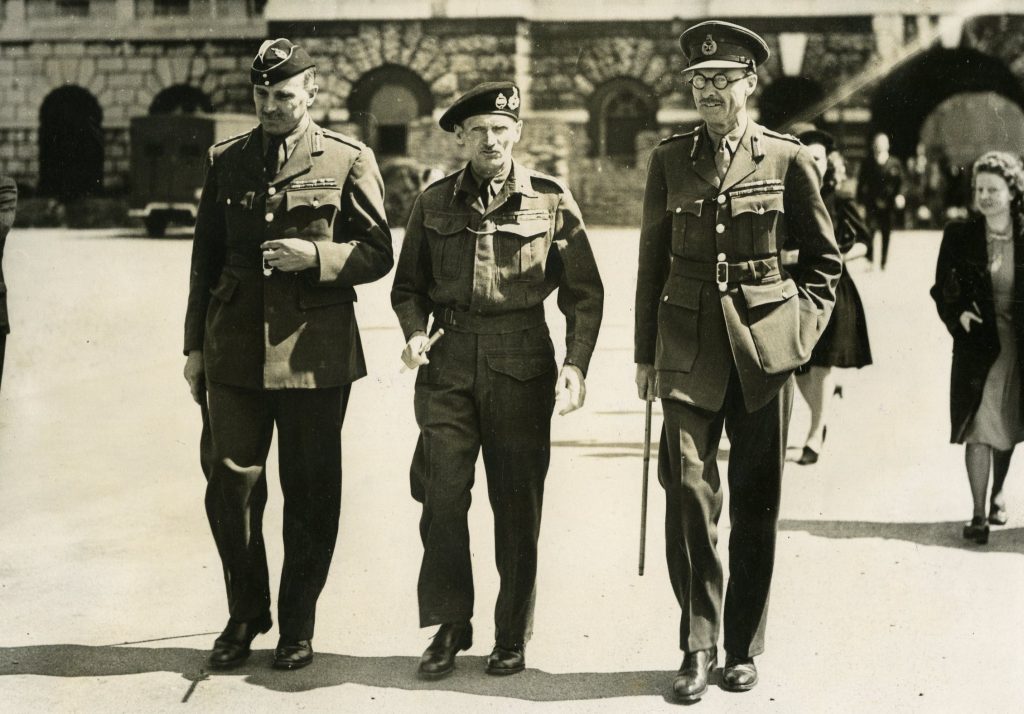
crossing Horse Guards Parade, Whitehall, June 1943.
South Lanarkshire Council collection
***
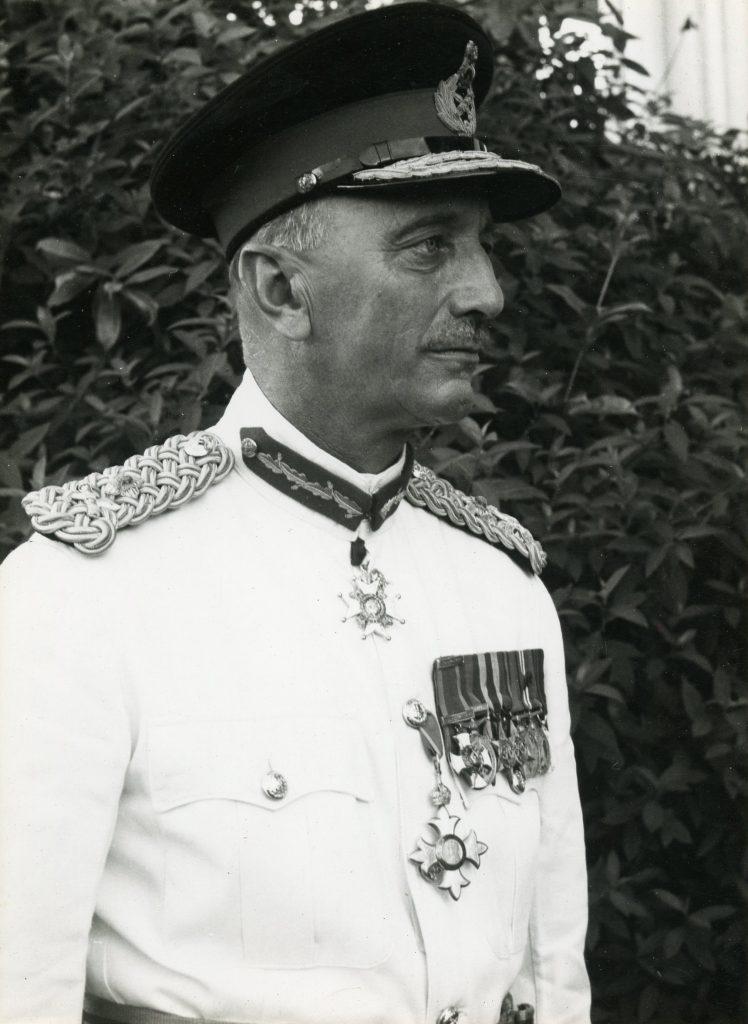
c.1957-1958
South Lanarkshire Council collection
Lieutenant General Sir George Collingwood KBE CB DSO was Colonel of The Cameronians (Scottish Rifles) at the time of the disbandment of the 1st Battalion. None of his illustrious predecessors can have had a more challenging or heart-wrenching prospect. He was much loved and admired by all in the Regiment. He rejoiced in the nickname by which he was widely known: ‘The Wicked Uncle’.
He was born in 1903 into a distinguished Northumbrian family and numbered the famous Admiral Collingwood (Nelson’s deputy and successor after Trafalgar) amongst his forebears. Indeed he was destined for the navy himself until it was discovered that he was colour blind. He went to RNC Osborne and then to BRNC Dartmouth before transferring to the RMC Sandhurst where he was a contemporary of ‘Nap’ Murray. They were commissioned into the Regiment on the same day in 1923. They succeeded one another as GOC Scotland and later as Colonel of The Regiment.
Collingwood’s early days with the 1st Battalion in India were notable for his sporting contribution. He captained what, for an infantry battalion, was a remarkably successful polo team. His interest in horses continued throughout his life. His crowning success in this field was when he was appointed a Steward of the Jockey Club. For those not familiar with this ancient institution which used to run British racing: it has only 120 members of whom nine serve as Stewards.
There was a pivotal time in his early service. When O’Connor was given command of 7 Division in Palestine he asked Collingwood to go as his ADC. As Baynes puts it: ‘Collingwood was rather old for such a post, and was used more as a personal advisor, friend and staff officer than the more usual role of an ADC’.[34] What better training could a future general possibly have?
While the 1st Battalion was in Malaya, 1951-53, Collingwood commanded a neighbouring brigade. It is thought likely that his nickname stemmed from this period. He always had a twinkle in his eye. There was always some mischief afoot. While commanding his brigade during the Malayan Emergency he asked his divisional commander, Major General Urquhart (veteran of Arnhem), if he might absent himself for four days. Pressed as to why it was so important to him Collingwood eventually explained that he planned to fly to Aintree to watch one of his horses running. Sadly, it did not win. (It should be noted in passing that this epic journey pre-dated travel by jet aircraft.)
Urquhart knew his man well. He was ex-Highland Light Infantry and Collingwood took command of their 10th Battalion in 1942 (at the same time that Murray took command of the 1st Gordons). From 1944 to 1945 he commanded the 33rd Indian Brigade in Burma (while the 1st Cameronians were with the Chindits). He then went back to India to command the 23rd Brigade (1945-46) and on promotion to Major General he commanded 52 Division, 1952-55. Between 1957 and ’58 he commanded the Singapore District before, on further promotion, he took over as GOC Scotland and Governor of Edinburgh Castle. It was thought to be unique then (and perhaps still is) that two officers of the same regiment succeeded one another in these posts. Not only that but he also succeeded Murray as Colonel of The Regiment, which post he filled from1964 to 1968.
When, as Colonel of The Regiment, he visited the 1st Battalion in South Yemen in 1966 it had left Aden for a tour up-country. He reminisced to that generation about how like the country and the operations were to those he had experienced on the North West Frontier 30 years earlier.
He died in 1986 at the age of 83.
***
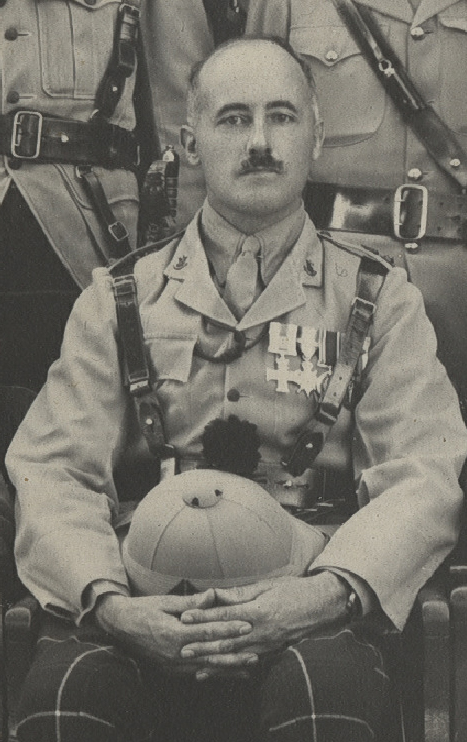
photographed as Lt-Col, Commanding 1st Cameronians, 1931
South Lanarkshire Council collection
Major General Robin Money CB MC was commissioned into The Cameronians (Scottish Rifles) from the RMC Sandhurst in 1909. He played polo in the subalterns’ polo team with James Jack (of whom more later).[35] He went with the 1st Battalion to France in 1914 and served there and in Flanders throughout World War I. When the 2nd Battalion was being re-formed in March 1915 after the carnage of Neuve Chapelle he was sent as the new Adjutant – a vitally important post and one which clearly showed the high regard in which he was held.[36] The previous month he and O’Connor were the first two members of the Regiment to be awarded the newly instituted Military Cross. He was wounded just two months later at the battle of Aubers Ridge.
He commanded the 1st Battalion in Lucknow and it was during his time that the foundations were laid for the run of outstanding sporting successes which followed, especially in the period 1935-38. Having handed over command in 1934 he returned to Lucknow two years later and was Commander Lucknow Brigade 1936-39. At the outbreak of war he was posted to be Commandant of the Senior Officers’ School where he replaced the later Field Marshal Viscount Slim (who went to command an Indian brigade instead).
He commanded the 15th (Scottish) Division 1940-41 and was then a Divisional District Commander in Northumberland and later in South Wales 1942-44 when he retired. He was awarded the CB in 1943.
It was a particular blow to him and his wife when their son, Roy, who had been commissioned in the Regiment from Sandhurst in the summer of 1939, was killed in action with the 2nd Battalion in May 1940 during the retreat to Dunkirk.
Money and O’Connor were contemporaries though the former was slightly the older. They were both commissioned into the Regiment in 1909. When they were both awarded the MC, Money was already an acting Captain. Both were wartime Adjutants of the 2nd Battalion. Money took command of the 1st Battalion in 1931 whilst O’Connor was nominated to take over in 1936, and in that year they were both given command of a brigade. In this regard they were role models for Murray and Collingwood who were to follow a generation later.
Money died in 1985, at the grand age of 97. His unique collection of photographs from the First World War are an important part of the Regimental Archives.
***
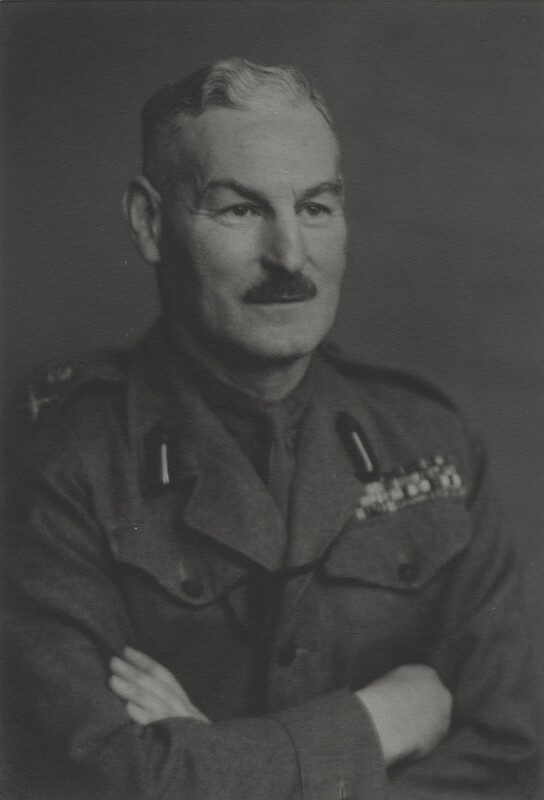
by Walter Stoneman
bromide print, June 1946
NPG x167913
© National Portrait Gallery, London
Major General Douglas Graham CB CBE DSO* MC DL was born in 1893 and was educated at Glasgow Academy. After a year at Glasgow University (where he distinguished himself at rugby) he entered the RMC Sandhurst from where he was commissioned into The Cameronians (Scottish Rifles) in 1913. The following year he was with the 1st Battalion when it went to France with the BEF. Within weeks he had taken part in the battle of the Marne but by October 1914 he was seriously wounded. Lying a long way out in no-man’s land he ordered his platoon to withdraw, leaving him behind. Two refused to do so. Corporal Taylor was killed; Private May carried him back about 300 yards under heavy fire and was, as a result, awarded the Victoria Cross. Although left for life with a seriously disabled leg and impaired hearing Graham returned to active duty and in 1916 asked to be posted to the 2nd Battalion in France. He finished the war as Brigade Major of a front-line brigade.
Between the wars he served on the staff, commanded the Regimental Depot in Hamilton and later went on to command the 2nd Battalion. He was in that post at the outbreak of World War II. In between, in 1925, he had returned from India to attend a course at the London School of Economics and Political Science. By early 1940 he was recalled from France to take over command of 27th Infantry Brigade, later renamed 153rd Infantry Brigade.
The new 51st Highland Division, of which the 153rd was part, were sent as reinforcements to the Eighth Army and he was awarded the DSO for his leadership of it at El Alamein. This award was followed only weeks later by a CBE. His obituary in The Covenanter takes up the story[37]:
During the latter stages of the Eighth Army’s long advance across North Africa from Alamein to Tunis, the commander of the 56th Division had been severely wounded and in May 1943 ‘Monty’ had appointed “That gallant old war-horse” to the command of that division in the rank of Major General. Thereafter he led that division during the remainder of the North African Campaign and later, during the landing at Salerno in Italy, where his gallantry had earned him a bar to his DSO.[38]
After injuring his arm and shoulder in the overturning of his jeep … he had been evacuated to UK where, upon his recovery in January 1944, he was given command of the 50th (Northumbrian) Division which he subsequently led in the Normandy Landings in June and throughout the first six months of the fighting in North West Europe. In recognition of the splendid part he played in those operations he was awarded the CB in 1944 as well as the French Legion d’Honneur and another Croix de Guerre.’
He retired from the army in 1947 but returned to uniform when he was appointed in 1954 to succeed O’Connor as Colonel of The Cameronians (Scottish Rifles). An American officer is said to have once asked the function of this far from purely honorary role, to be told that it was to be the ‘Father of the Regiment’. So great was his paternal interest that he was universally and affectionately known as ‘Daddy’ Graham.
Montgomery coined the nickname ‘The Gallant Old War-horse’. Many knew him as ‘Noisy’ Graham for the gusto with which he was prone to greet acquaintances. (The1915 damage to his hearing was also a contributing factor.) There is no doubt however that he took real pride in his sobriquet, ‘Daddy’. It was the pinnacle of a long and illustrious career.
He died in 1971 in his 80th year.
***

South Lanarkshire Council collection
Major General Norris Haugh received a wartime commission in The Cameronians (Scottish Rifles) in 1915 and joined the 7th Battalion in Egypt where it was re-fitting after the withdrawal from Gallipoli. He served with them on operations against the Turks in Sinai and in Palestine. When the 52nd Lowland Division was moved from the Middle East to the Western Front in France he served there until September 1918 when he received serious wounds which ended his war.
In 1919 he applied for and received a regular commission in the Regiment, joining the 2nd Battalion in Colchester in time for them to leave for their tour in India. In 1923 he was with them when they were hurriedly transferred from Quetta to Iraq to take part in a punitive expedition against the unruly Kurds. By this time he had been appointed Adjutant. He continued to serve with the 2nd Battalion in Quetta until the Battalion left in 1927 when he remained behind to attend Staff College. Apart from a short spell with his battalion in 1937 he spent the rest of the inter-war years on the staff. His appointments included that of Brigade Major 6th Infantry Brigade and Grade II (major’s) appointments in Egypt and in UK.
On the outbreak of war he was appointed to command a battalion of [another] regiment. From 1941 to 1942 he commanded 145 Brigade which was based in Devon and later that year he was posted to Northern Ireland as Brigadier General Staff. He then returned to the Middle East in the rank of Major General where he was Deputy Chief of Staff Middle East Command 1943-44. In 1945 he was made Deputy Quartermaster General (under Riddell-Webster).
Like so many he had to revert to his substantive rank and it was as a Brigadier that he went once more to the Middle East, this time as Chief Administrator Cyrenaica. After the end of the British Mandate in Palestine and the withdrawal of British troops his job was subsumed into the headquarters of GOC 1st Infantry Division, none other than Major General Murray. Haugh retired from the army in 1948 after thirty three years service. Of his life and service his obituary in The Covenanter says:[39]
… he retired at the end of a distinguished career in the honorary rank of Major General but, strangely enough, without any of the customary (and in his case, well-merited) decorations to mark his country’s appreciation of his long and valuable service and of the part he played in two World Wars. This has never ceased to be a source of deep mystification and profound regret to all his many friends who have felt that he had been the victim of sheer mischance, and of some mistake that ought long ago to have been corrected. After all there can have been few (if any) other officers who, having risen from the rank of Major to Major General in the late war, had not received some award …’
Ill health prevented his attendance at the Disbandment Conventicle.
He died in 1969 at the age of 75.
***
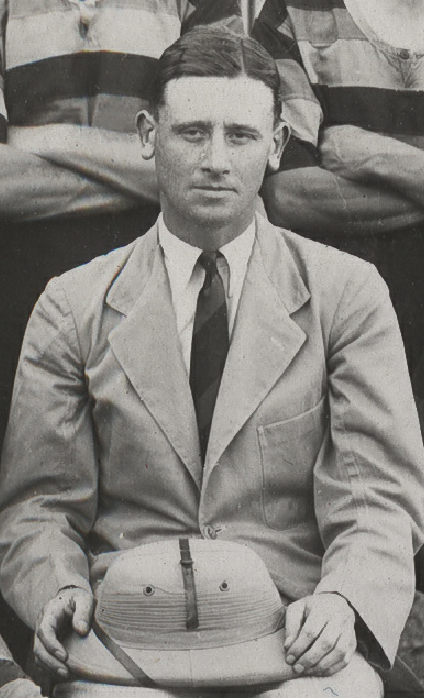
photographed as Lieutenant and Adjutant,
1st Cameronians, India 1934
South Lanarkshire Council collection
Major General Eric Sixsmith CB CBE was born in 1904, went to school at Harrow and then to the RMC Sandhurst. From there he was commissioned in The Cameronians (Scottish Rifles) in 1924. He served with them in China and Egypt and later in India. He was Adjutant of the 1st Battalion 1933-35 after which he went to Staff College. Still a subaltern he was one of the youngest students. There he benefited from the teaching of the future Field Marshal Viscount Montgomery. Two staff postings followed and he was Brigade Major, 2 Infantry Brigade, at the outbreak of World War II.
Thereafter his service alternated between command and the staff. He was GSO 1 of 51st Highland Division from where he went to command the 10th Cameronians. Recalled to the War Office for a year he was then appointed to command the 2nd Battalion Royal Scots Fusiliers in Algiers. He was wounded at Anzio but returned to active service in May 1944 to assume command of the 2nd Cameronians, but his tenure was short. He was appointed Deputy Director of Staff Duties in the War Office in the rank of Brigadier.
He remained there until 1946 when he was sent to India to command 13 Independent Brigade Group. Two years later he was back at the War Office as Deputy Director of Personnel Management. A year at the Imperial Defence College followed that and from there he was posted to Hong Kong as Chief of Staff. Thence he was sent to the equivalent position at HQ Far East Land Forces in Singapore with the rank of Major General.
In 1954 he returned to UK for his last command which was of South West District and 43 (Wessex) Infantry Division. Following this he became Director of Organisation and Training at SHAPE in Paris and retired in 1961.
Of him a friend and contemporary said:
One of the first characteristics I remember was that he was a very Spartan officer. Quetta [where they were at Staff College together] can be very cold, but no one ever saw him huddled in a greatcoat, and he was reputed to sleep cheerfully in the open under one blanket. [He was also seen late on in life, working in his garden in the snowy conditions of a February day, clad in his army issue tropical shorts.]
… He was a man of the greatest integrity. He did what he believed to be right at whatever cost, and his principles were always stated clearly and could rarely be shaken in argument. …
But the adjective I would apply to him above all others was ‘incisive’. His was no hurried judgement. A question … would provoke a pause for thought, and then his answer, clear and forceful, would leave no-one in doubt on his opinion. [This, word for word, could be Barclay’s description of Riddell-Webster – see above.] In spite of this I imagine he was more valuable as a staff officer than as a commander, and that is proved by his series of senior staff appointments during and after the war. I cannot imagine a better Chief of Staff, meticulous in gathering the relevant information, and presenting the situation to his commander with unprejudiced clarity. He was an officer who inspired confidence in his opinions which one knew had never been formed lightly.’
In retirement he started a new career as a writer and historian. Between 1970 and 1976 he wrote a series of widely acclaimed books. Of these his British Generalship in the Twentieth Century became something of a classic, and required reading for any aspiring staff officer.[40] He also lectured on military history at Southampton University and at the Staff College, Camberley.
He had many other interests as well. He was at one time a keen piper, he won prizes for fencing at RMC Sandhurst, and several point-to-point races in India. He was a knowledgeable and avid gardener, he enjoyed classical music and he was a committed Christian who gave of his significant gifts both to his local parish and beyond.
He was appointed CBE in 1946 and CB in 1951. He died in 1986 at the age of 81.
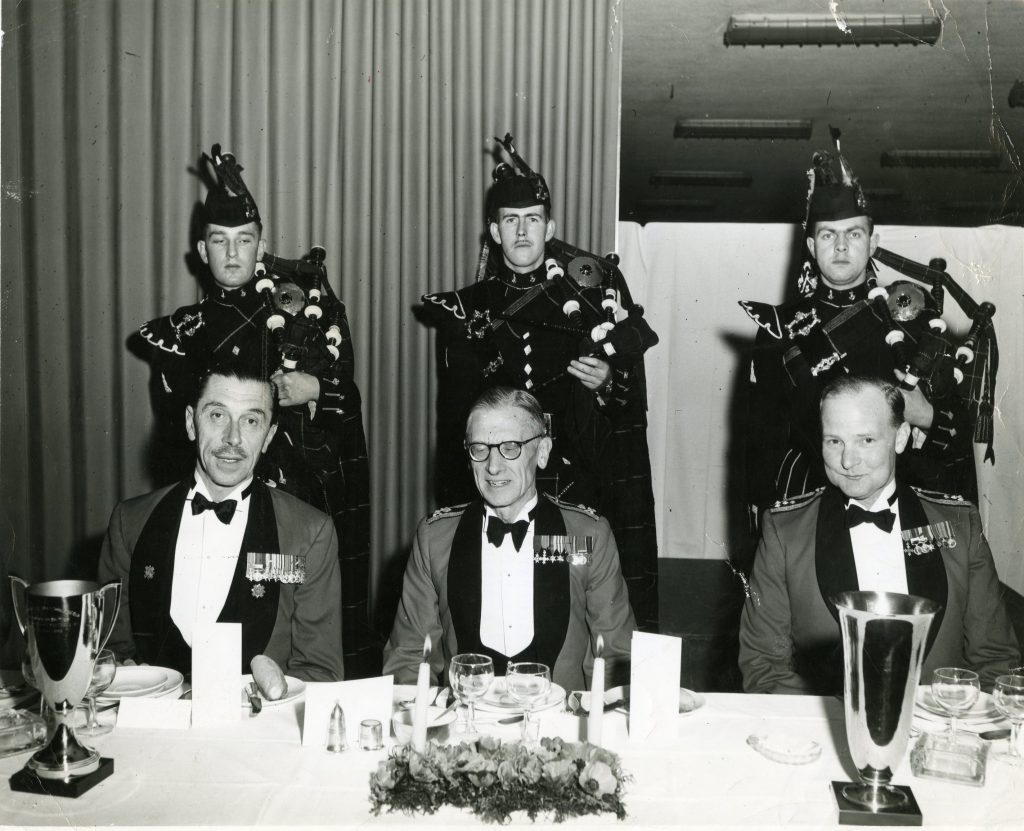
The pipers are from 1st Battalion The Cameronians (Scottish Rifles)
South Lanarkshire Council collection
***
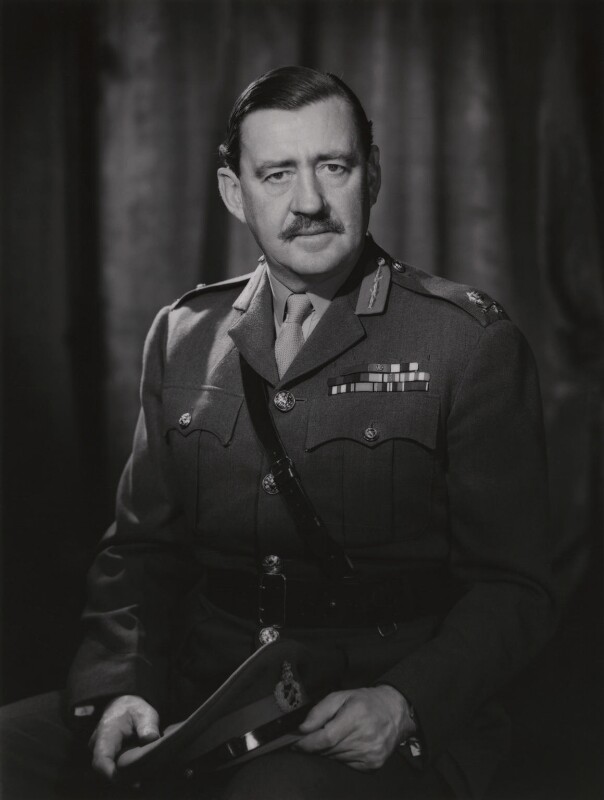
by Walter Bird
bromide print, 23 January 1967
NPG x167694
© National Portrait Gallery, London
Major General John Frost CB DSO* MC. His obituary in The Times began:[41]
‘Johnnie’ Frost carved his name in the annals of Anglo-American military history by reaching and holding the bridge at Arnhem until his ammunition ran out in September 1944, although surrounded by SS Panzers. His name was later illuminated by Conelius Ryan’s book and the Richard Attenburgh film, A Bridge Too Far in which he was portrayed by Anthony Hopkins. He was a founder member of ‘2 Para’, and his indomitable leadership as adjutant, company commander and then commanding officer, established its fighting traditions …
He was born in 1912 and educated at Wellington College and Monkton Combe. He was commissioned into The Cameronians (Scottish Rifles) from RMC Sandhurst in 1932. After early service with the 2nd Battalion (under Riddell-Webster, with whom he no doubt hunted) he later went on secondment to the Iraq Levies with whom he served until 1941.
Having volunteered for Special Forces in 1941 he was posted to the new 2nd Battalion the Parachute Regiment. He then took part in many operations but three were to earn him fame as an inspired and inspiring leader. The Times takes up the story:
Frost’s first task … was to lead the raid on the German radar station at Bruneval on the French coast … on the night of 27/28 February 1942. British scientists needed the cacinotron from the heart of one of the latest German radars in order to devise counter-measures. Frost’s C Company was to drop on Bruneval and protect the radar specialist … team while they dismantled the radar and carried it back to a waiting Royal Naval craft.
The Bruneval raid was one of the few entirely successful Second World War parachute operations, thanks to Frost’s meticulous planning, training and inspiring leadership. His hunting horn [a gift on his departure from Iraq] was heard for the first time in battle, as the Bruneval garrison was over-run and captured or killed while the radar was being dismantled. His force escaped in the nick of time … as German tanks reached the cliffs above the beach. The Military Cross was his reward.
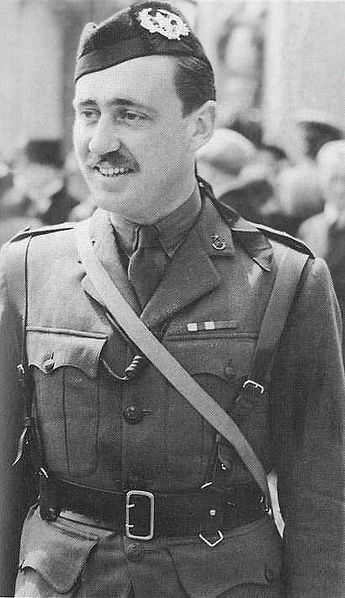
Writing in The Covenanter[42], Max Arthur said:
It was a short, sharp, highly successful operation for which C Company received a hero’s welcome in the Solent with Spitfires dipping their wings overhead and naval vessels playing Rule Britannia. The raid had been carried out when the country’s fortunes had been at a low ebb. … Frost was called to Downing Street to relate his experiences to a delighted Churchill.
In November of that year his battalion sailed to take part in the Allied invasion of French North Africa. His commanding officer succumbed to illness and Frost assumed command of 2 Para. Their first operation was nearly a disaster as they had to fight back to their own lines over 30 miles away from where they were dropped. In the subsequent fighting in Tunisia the Battalion repelled three successive attacks by German paratroopers, the third time only after a desperate struggle. The Times again:
In the fighting to re-take Sedjennane, Frost, sounding his hunting horn, led the decisive bayonet charge which obliterated the remnants of the Witzig Group. He received his first DSO for his battalion’s part in the Tunisian Campaign.
After more fighting in Sicily and Italy in 1943 the 1st Airborne Division was withdrawn to prepare for use in France and Belgium during the summer of 1944, but nothing came of the many plans until the Arnhem operation which began on September 17. The Times:
Frost’s 2nd Parachute Battalion was given the task of advancing as rapidly as possible along the north bank of the Lower Rhine to capture and hold the railway and road bridges in Arnhem some eight miles away from the dropping zone. There were said to be only lightly armed … units in the area. So confident was Frost of success that he ordered his batman to load his golf clubs and shot gun in his follow-up baggage.
… little went right: the 9th and 10th SS Panzer Divisions were refitting in the area and, although taken by surprise, were soon opposing the British advance into Arnhem. Opposition grew in intensity and the Germans succeeded in blowing the railway bridge just as Frost’s men were approaching it. It then took until dusk for the battalion to fight its way to the northern end of the road bridge, but all attempts to cross it are driven back. For the next three nights and two days Frost held the buildings around the north end of the bridge against a succession of determined German tanks and infantry attacks while the rest of the division tried to reach him. During the third night he was badly wounded by a mortar bomb. Soon afterwards the Germans managed to set on fire the upper floors of the building in the cellar of which the severely wounded were being sheltered. Fearing that they would be engulfed in flames, he finally agreed to surrender. The Bar to his DSO recognised this and his men’s stoical endurance; and the Dutch later named the re-built bridge after him.
Frost’s post-war career was unexceptional. He attended Staff College and the Senior Officers School. He commanded the Support Weapons Wing at Netheravon (1955-57), the 44th Parachute Brigade TA (1958-61), Lowland Divisional District (1961-64) and finally he was GOC British Troops Malta and Libya (1964-66). There his relations with the Diplomatic Corps were not as smooth as might have been hoped and, instead of any further employment or promotion, he retired in 1967. Of his character The Times said:
… he had deep reserves of courage and willpower. He inspired his officers and men, who had implicit faith in his personal integrity and confidence in his military judgement. He was surprisingly modest and discrete for a man with his strength of character; indeed he was quite shy.
In common with most of his contemporaries he made the most of his sporting opportunities. He boxed, enjoyed fishing and shooting as well as golf. It was the hunt in Iraq which had presented him with his famous hunting horn and he played polo, taking it up again with enthusiasm in Netheravon and in Malta. In retirement he became a successful farmer.
He died in 1993 in his 80th year, the last of The Generals to survive.
***
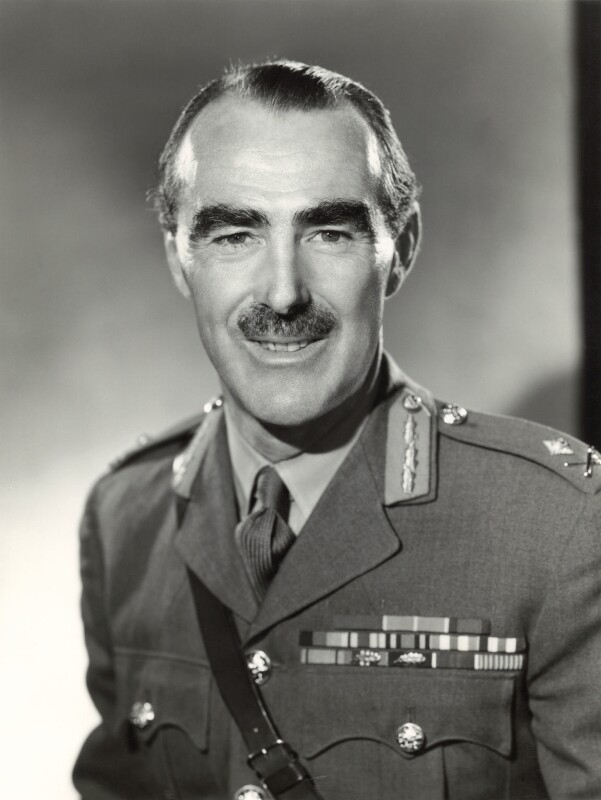
by Walter Bird
bromide print, 7 June 1962
NPG x163478
© National Portrait Gallery, London
Major General Henry Alexander CB CBE DSO. Yet again we are indebted to the obituarists of The Times. Their assessment was published in full in The Covenanter[43]:
[Alexander] was an able officer of positive character, with a quick brain, an original turn of mind and a pungent tongue. Never afraid to take a decision or to proclaim what he thought, his forthrightness more than once led to a clash with higher authority. It was almost certainly this trait which prevented him from reaching higher rank in his chosen profession.
… Educated at Sedbergh and Sandhurst he was gazetted to The Cameronians in 1931, returning to Sandhurst as an instructor a year before the war. Small, slim and always fit, he made his mark both on the polo field and as a gentleman rider. His war service was unusually varied and he held every campaign medal except that of the Pacific. He commanded the 2nd Battalion of his regiment in Italy and was a full colonel on the operations staff of General Wingate during the second Chindit Expedition into Burma in 1944. In 1946 he became Chief Instructor at the newly established School of Combined Operations; he was later an instructor at Camberley [Staff College] and a student at the Imperial Defence College. [He also commanded the 1st Battalion, 1953-55, and a Brigade during the Malayan Emergency, for which he was awarded the DSO in 1957.]
In 1959 he was offered and accepted the appointment of Chief of Defence Staff in Ghana. Arriving there early in 1960, he quickly got onto good terms with President Nkrumah and addressed himself to the difficult task of building up an army, navy and air force in a political atmosphere from which corruption was not absent.
In July of that year, trouble broke out in the Congo, the United Nations were called upon to intervene, and the Ghana contingent under Alexander was among the first to arrive. … Alexander found himself the senior non-Congolese on the spot. … With the approval of the UN representative, and at considerable personal risk, Alexander succeeded in persuading mutinous Congolese soldiers to lay down their arms, and generally imposed his strong personality on a chaotic situation. …
For some time he continued to receive the backing of Nkrumah, with whose full approval he visited the UN in New York to acquaint them at first hand with the problems of the Congo. This visit did not endear him to certain British circles, and within Ghana pressure was being brought to bear on Nkrumah to rid himself of the British element in the armed forces. … Alexander was summoned to Nkrumah’s office and handed a letter of dismissal, to take effect immediately.
…Alexander produced a readable and surprisingly tolerant account of his service under Nkrumah.[44] At the time, however, he had been less tolerant, both in statements to the press and on television, in his strictures on some British political decisions; and his generally expected appointment as GOC Scotland [where he would probably have succeeded Collingwood] did not materialise. After three years as Chief of Staff Northern Command he retired and went into industry.
In the same issue of The Covenanter there appeared an appreciation by Lieutenant Colonel Duncan Carter-Campbell OBE.
I first met Henry in the summer of 1931 … and remember him as a small, dark and very dapper young man. We soon discovered we were going to join the same Regiment – The Cameronians (Scottish Rifles). He told me at the time that he had heard from several sources that this regiment took soldiering very seriously – that this was the regiment to join if you wanted to get on. Henry was a most attractive and colourful character and very amusing. …
He was already an accomplished rider on joining the Army and received great encouragement from the Commanding Officer, Lt Col Tom Riddell-Webster, who always took as many subalterns as possible out hunting. …
Posted to the 1st Battalion in Lucknow in 1932 he immediately got down to learning the art of polo. … At the same time he was a hard-working and enthusiastic regimental officer. He was Signal Officer and became Adjutant in 1938 [while still a subaltern and after only seven years of service]. Even in these early days of his career, it was clear that he would rise to high rank in the Army. He was perhaps a hard taskmaster, but recognised by all as a great teacher, post-war, of the new blood.
An earlier appreciation gave space to much more of his sporting prowess.[45] He was undoubtedly the best rider which the Regiment produced. He went to London in 1937 (from Lucknow) to play as a guest in a polo team ‘which swept the board’. In 1938 the 1st Battalion team won the All-India Infantry Cup (as well as many others). In 1939 he was invited to join the team of the Maharajah of Jaipur which toured America. One of the other players was Lord Louis Mountbatten. It is therefore of little surprise that he was later to join the Combined Operations Staff which was commanded by Mountbatten. But his greatest feat as a horseman was to win the Foxhunter Chase in 1951. It was run over the Grand National course at Aintree (lasting ‘only’ 1¼ circuits as opposed to two). In the race he rode Pampeene II which he also owned and trained. For an infantry officer this was (and probably still is) a unique achievement.
His name made the headlines once more in 1968 during the Biafran War when a journalist, a certain Jonathan Aitken – later a Defence Minister in the Major government – was alleged to have broken the unwritten rules of clubland by disclosing a confidence offered to him by Alexander. The result (after a court case which did not involve Alexander) was the setting up of the Franks Committee on the workings of the Official Secrets Act. The Times said: ‘… it was an unhappy postscript to a distinguished and eventful career.’
It would be wrong however to close on a negative note. Alexander had not yet made his final contribution. At the beginning of 1969 he succeeded Collingwood as the Colonel of The Regiment. It was a difficult time. The 1st Battalion had just been disbanded. There remained a disparate collection of territorial and cadet units as well as a Regimental Headquarters and a Museum. Alexander is remembered with great affection for his industry, commitment and devotion to his old Regiment. After nearly six years (in a post which was down-graded to Representative Colonel) he handed over to Brigadier David Riddell-Webster OBE, son of his first Commanding Officer.[46]
He died in 1977 at the comparatively early age of 65.
***
So what are we to conclude? What, if anything, did The Generals have in common? Was it shared background or was it experience? In other words was it nature or nurture? Was this extraordinary crop simply a matter of chance? That cannot be wholly discounted but, as we shall see, it seems likely one can draw a different conclusion. Even if we put it all down to coincidence it does not alter the facts or the outcome. Murray in an important memoir coined the phrase A Gaggle of Generals.[47] With some trepidation the writer would suggest that, although attractively alliterative, the phrase does not really do justice to them. Perhaps Murray was just being modest. Although one associates a gaggle with a group which is upright and alert, there was certainly never any quacking or waddling. Henceforth they will be referred to as a pride, as in lions, for lions they were.
Perhaps one should start by examining what they all had in common. The most obvious is simply the fact that they were all the product of the same small nucleus. Having joined the same regiment they were then to live together, to eat together, to take part in sports together, to compete and to cooperate in every aspect of life. Most importantly they were bonded in their primary aim: to make their battalions the best fighting units in the army. There were elements of cooperation and many of competition, not least at that time between the two battalions. For those not fortunate enough to have enjoyed life in a regiment one must explain: it was far more than a job. It was a way of life. It was at a time when, with few of the distractions of life today, they were to become as close-knit as any other family and a great deal more so than many families today.
Without doubt and without exception all of the generals succeeded because they had outstanding abilities. All were professional soldiers who had risen to the challenges of service through at least one and, in more than half the cases, both World Wars. They had the character, the temperament, the will, the drive, the resolution to persevere through difficulties unimaginable to most people. They also had good fortune. First they were fortunate enough that in spite of the wounds that several suffered, they all survived. Secondly they were fortunate to be in the right place at the right time, or, to put it another way, not to be in the wrong place at the wrong time – though O’Connor is the outstanding example of how to be in both (at different times). Napoleon’s dictum about luck and generals has always held good.
It is an extraordinary feature of the group that so many not just survived but lived to advanced old age. The reader will have been struck already with their longevity. What is even more remarkable is that the older they were the older they got. To explain: the eight who fought in World War I reached, on average, more than 86 years. Adding in the other five, the average age of all of them together comes down to 83, still higher than the average life expectancy of a male born in Britain today (2005). It is hugely greater than the expectancy of someone like Riddell-Webster, O’Connor or Money who were all born in the 1880’s. Perhaps the experience of fighting through and surviving the Great War gave them an extra appreciation of life and a steely grip on it. More likely it was a facet of their characters which helped: that awareness, that keenness, that alertness, enthusiasm and vigour which comes through so often. This at least was something they all had in common.
What was it then which in the first place drew them all together? What elements of their background did they have in common? True enough they all chose to join the same regiment but that was for different reasons. In the case of the later ones, Alexander certainly and probably Frost too, it is clear that the word was out: it was the regiment to join if you wanted to get on. The generation before that, Murray and Collingwood, joined when Captain (later Brigadier) AC Stanley Clarke was an instructor at Sandhurst. On the other hand we are told that O’Connor was delighted to join, though disappointed that there was no vacancy in the Argyll and Sutherland Highlanders where his cousin was serving already.[48] In earlier days it was no doubt as much to do with vacancies as with any particularly long family or other tradition.
The regiment they joined has been well described by Colonel HH (Harry) Story MC, author of Volume II of the Regimental History.[49] He wrote (in 1961):
Fifty years ago, social conditions, so utterly different from those of today, were reflected, naturally, in the Army. Regular officers were drawn from traditional Army families, from the landed gentry and from the Church and legal profession. For the most part they entered the Army for life. A few were well off, but most of them had to depend on a small allowance from home for the early years of their service. Pay was low. On first joining, a 2nd Lieutenant received 5s 3d a day [26 pence then, and about £18 in 2005]. He was required to pay for his food, to provide and maintain Service Dress Uniform, Full Dress, Patrol Dress, Mess Dress, civilian clothing [including formal morning and evening dress] and furniture for his quarters. … Great emphasis was placed upon physical toughness. Officers were expected to be good horsemen and to follow all field sports.
Baynes sets the scene for 1909 when O’Connor joined:
Although not a rich regiment, as they went in Edwardian days, it was necessary to have a private income of £ 100 a year at the very least, [roughly equivalent to £ 7,000 in 2005[50]] and preferably twice that amount, to serve in the Scottish Rifles. … nearly all officers shared similar interests and backgrounds and had been educated at the major public schools, so they did the same things, but in various degrees of style, and at different levels of expense.[51]
At least half of the generals came from Army families. O’Connor’s father was a Major; Evetts’s was a Colonel, but Frost’s father was a Brigadier whilst Alexander’s was a Major General – an interesting progression. It seems therefore that the Regiment’s reputation eventually had an effect on recruiting. The Commander 1st Burma Division in 1942, writing to the Commanding Officer of his appreciation of the 1st Battalion, made an interesting comment: ‘If I had my time again I should try hard to be posted to The Cameronians – I can’t say more …’[52] It should also be noted that of those who had sons (neither O’Connor nor Murray had any children and Collingwood did not marry) four joined the Regiment. Of the four, one was killed very young and one died prematurely. One should have commanded the 1st Battalion but did not. One, already mentioned, commanded the 1st Battalion in Aden and later became the last Representative Colonel.
Mention has been made of horsemanship. Equitation was central to the curriculum at the Sandhurst. Being an infantry regiment there was no great military requirement for riding. True, the Commanding Officer, Adjutant and Field Officers would have chargers and did ride, as did the transport officer, but an average proficiency was probably all that was called for. (One Transport Officer, John – later Lord – Reith of the 5th Battalion, entitled his wartime memoirs Wearing Spurs.[53] He went on to be the founding father of the BBC.) What comes across clearly however was the degree to which mounted sports were not just a shared interest but an enthusiasm. Time and again we hear of officers hunting and riding in point-to-point races, and we hear of the legendary 1938 polo team which was captained by Collingwood and in which the star player was Alexander. A great friend of Alexander’s, also in the team of four, was Lieutenant (later Lt Col) Sir Edward Bradford Bt. Alexander’s feat at Aintree is made the more remarkable considering that news reached him that very morning that his great friend Bradford, then commanding the Regimental Depot, had been killed riding in a point-to-point. Worse still: Alexander read it in a newspaper.[54]
Even the horsy sports can be sub-divided and provide lessons. Hunting is a sociable recreation (though arguably not for the fox). Races would have been fiercely contested. Polo requires teamsmanship of the highest order. So there you have the requirements of a young officer encapsulated. He co-operated to the hilt when required, he contested like mad when needed, and he socialised to taste.
Colonel Story mentions above the emphasis on sport. Its competitive element is brought out well when we consider the exploits of Lieutenant WD (Billy) Croft – of whom more later. An entry in the Regimental Wager Book records that he won a bet in 1910 that he could in the space of one hour: cycle a mile, ride a mile on horse-back, run a mile, walk a mile, row a mile in a racing skiff, and swim a mile – in that order. He did it in 58 minutes; none of it using a metalled road. And after a wash and brush-up he spent the rest of the day hunting![55]
The benefits of horsemanship have been explored many times elsewhere. Here is Sixsmith (himself no mean horseman):
There is no doubt that the horse is better and quicker across country than man or machine, and there is no doubt that the hunting field gives a better opportunity than any other peace-time training for developing an eye for country, the initiative, and the dash so necessary for junior leaders in war.[56]
No doubt, but it is also worth pondering that the two generals who were given command of armoured divisions in World War II, Murray and Galloway, and the former with outstanding success, are the exceptions to the rule in-so-far as their interest in equitation is concerned. Doubtless they were proficient, but it is noticeably lacking from their listed sports and interests. Perhaps the fact that both were large men has something to do with it, but that has nothing to do with their tactical appreciation and their ability to manoeuvre highly mobile formations in the field.
I have long been fascinated by what motivated clusters of genius. I have in mind the creative masters of Renaissance Florence, the philosophers of Edinburgh during the Enlightenment, the musical composers in Vienna at the end of the 18th century, and the artists in Paris a hundred years later. What was it that all of these movements had in common? It seems to me that it was not so much that they did the old things better: it was that they did something new. They used their great talents, their genius, to make a change and to usher in a new era. In the case of the officers of The Cameronians (Scottish Rifles) it was professionalism. For sure, officers of all regiments showed courage, a sense of duty, commitment and all of the other soldierly qualities. What marked this new breed was that they had a new approach. They wanted to be the best at everything they did. They wanted to be the best and most importantly the most professional soldiers. And in all of this they were encouraged by their seniors and they encouraged one another.
The single thread which runs through all the biographies is this professionalism. It is perhaps this more than any other trait which we would do well to examine. What was its origin and why was there such a drive, and indeed why were they all so driven and so successful? Before considering that in a personal or regimental context it is necessary to look at the army in general.
After each of the major wars, Franco-Prussian, South African and World War I, there was an inquiry and reforms were put in place. The one after the South African War, the Elgin Commission, and more importantly its promulgation by the new reforming Minister, Richard (later Viscount) Haldane, had two main outcomes. One was the establishment of a full-time staff headed by generals on an Army Council. The other was a change in emphasis on the training of junior officers. Both of these outcomes were to have an effect on those commissioned between 1904 and 1914 and, inevitably, on all of those commissioned since. The first required a steady flow of well trained staff officers and therefore placed a much greater emphasis on staff training. The second is dealt with succinctly by Sixsmith:
The development of tactics showed that the officer had a completely new role to play. It was no longer sufficient for him to bring his men to the point of battle and then lead them blindly against the enemy. Both staff officers and regimental officers must be professionals in every sense of the word.[57]
It is a cliché to say that the Great War had a profound effect on the lives of those who took part in it. But in this context what was important and what endured in the changed world which followed it was an experience of what long term, large scale hostilities were like and what had to be achieved to produce a better and more professional army. Riddell-Webster, Money, O’Connor, Evetts, Graham, Galloway, and Haugh (as well as Bucher) had all served. Most had held positions of considerable responsibility as well as showing themselves to be courageous regimental officers. Their influence on those who followed on was pivotal.
Here mention must be made of an older generation than those above, the ones who provided the leadership and example to the younger element at the start of that war. It is not suggested here that The Cameronians (Scottish Rifles) were any more productive of talent or gallantry in World War I than any other regiment. Each regiment produced its heroes and success stories. Perhaps, though, there was already a consciousness that life was changing and with it the profession of arms. What cannot be denied was the contribution made by the older generation to the younger ie those joining in the last years ‘before the lights went out’.
Much of the information on this era is based on the helpful reproduction of the Army Lists for 1914 and 1919 to be found in the Regimental History.[58] It shows the names of all of the officers serving in the Regiment at the outbreak of war and all of those who survived and who were still in the Regiment at its end. It shows that in spite of their war-time exploits all of the above were still Captains, with their seniority as listed here above. (Haugh, the exception, was still a subaltern; Bucher had moved on.) It also shows several older officers who had distinguished themselves including:
(The rank in brackets is their substantive rank in the Army / Regimental List in 1919.)
Major General GTC Carter-Campbell DSO (Lieutenant Colonel, Brevet Colonel)
Brigadier General R Oakley DSO (Major)
Brigadier General JG Chaplin DSO (Major)
Brigadier General I Stewart DSO (Major)
Major General ES Girdwood DSO (Major)
Brigadier General WD Croft DSO*** (Major, Brevet Lieutenant Colonel)
Brigadier General JL Jack DSO* (Major)
Space here does not allow more than brief mention of three of them.
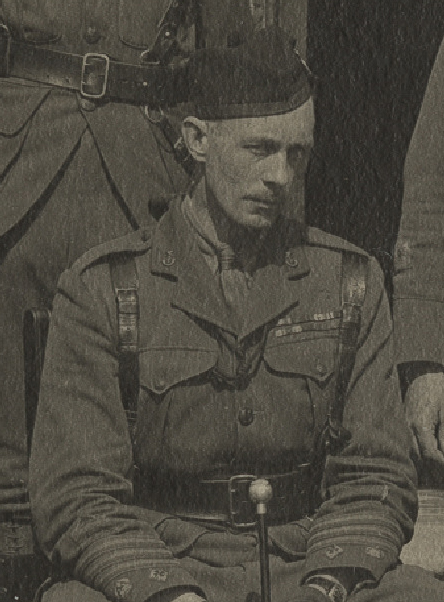
Officer Commanding Regimental Depot, Hamilton
c.1920-1921, South Lanarkshire Council collection
James Jack earned fame not just because of his rank and his double DSO. He was also the writer of one of the definitive memoirs of World War I, though they were not published until after his death.[59] Of them the celebrated historian, author and broadcaster John Terraine (who edited them) wrote:
This is not literature, as such; the language is the language of the mess, the orderly room, Standing Orders [etc] …So much the better; this creates a stiff-jacket for emotion and passion. … With them go other qualities, not to be overlooked: a stern conception of duty, the keen attention to details at all times, the ‘eye for country’, sharpened by training – and by hunting, a sense of history, instilled by the Regiment. In short this is a true chronicle of the British professional soldier, at a time when he was worth his weight in gold.
Jack, we are told, ‘had been made Adjutant of the 1st Battalion in 1910 although still only a 2nd Lieutenant, in those days of slow promotion’.[60] As such he would have had a profound influence on the new officers who would have watched his advancement with awe. Having heard what Jack had done, it is at least possible that Frost used him as a role model and made the use of his hunting horn on the battle-field, first at Bruneval, then in North Africa, and later at Arnhem such a trademark. Jack reverted to his substantive rank and commanded the Regimental Depot 1919-20. As a result of an accident steeple-chasing he was forced then to retire from the Army – though not from hunting.
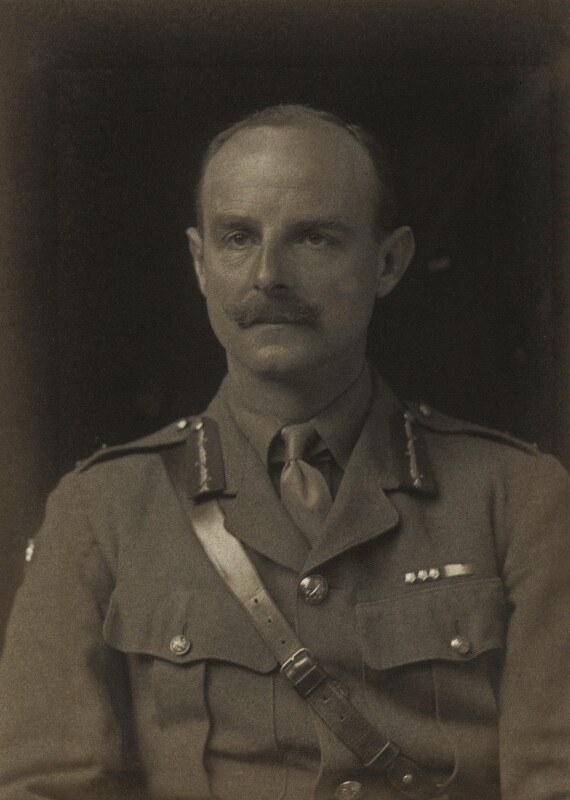
by Walter Stoneman
bromide print, 1918
NPG x166864
© National Portrait Gallery, London
The year that Jack became Adjutant of the 1st Battalion, Croft won his famous wager. At that time he was Senior Subaltern of the 2nd Battalion. He had assumed that role on his return from colonial service in 1908 and was to remain in it for three years. His obituary in The Covenanter says of the role that it was ‘… a position which in those days carried considerable responsibility’.[61] It goes on:
Just before the end of 1915[62] he was sent to the 27th (Lowland) Brigade to command the 11th Royal Scots and, in September 1917, he was given command of that brigade, an appointment he continued to hold throughout the remainder of the hostilities. For his distinguished services and gallantry during the 1914-18 War, Brigadier General Croft had been awarded the DSO with three bars, the CMG and the Legion d’Honneur, and had been Mentioned in Despatches 10 times.
This record, which eclipsed even O’Connor’s, earned by one so well known to the generation which followed, must have had an indelible effect on them. (Remarkable as it was, his record was not unique. Six other officers also won four DSO’s in the First World War, but none more.)
Girdwood became a Brigade Major in 1915 while still a Captain and of him more follows. His influence too was to be enormous, though mainly later on.
Reverting only briefly to the subject of longevity: it is worth noting in passing that the three older officers mentioned above also reached great old age. When he died, Girdwood was 87, Jack was 82 and Croft was 89! It is a remarkable coincidence that their average age – 86 – is the same as that of the eight others who survived the Great War and who are referred to earlier.
In the aftermath of the war the peacetime battalions had to be re-built. This called for a devotion to duty of the highest order. There were two significant appointments that were to shape the careers of many in the Regiment for years to come. The first was of a new Commanding Officer for the 1st Battalion; the other was his Adjutant. The former was a highly experienced and totally committed regimental officer, Lieutenant Colonel EB Ferrers DSO, known universally as ‘Uncle’. His Adjutant, who had not long previously filled the same role in the 2nd Battalion, was O’Connor. The 1st Battalion needed sorting out after a long period in Ireland during the post-war troubles and there could have been no two officers better suited to doing it. Their legacy was to last for generations.
Before going on to this post-war period it is worth looking back just once more to the pre-war days. It was nothing new to find that good officers were put into these posts though in fairness it was perhaps sometimes the case that the Commanding Officers were products of the ‘Buggin’s turn’ method of selection, based on seniority, while his staff officer, private secretary, fixer and enforcer was selected from the ranks of captains (or occasionally subalterns) with the right experience, in their late 20’s.[63] They were usually seen as the rising stars. They would usually serve for about two years. Those not selected to be Adjutant of a regular battalion would be sent to that role in one of the territorial battalions. This is an important point and we shall return to it again.
It is no coincidence then that at the outbreak of war we find Captain JC Stormonth-Darling, Adjutant the 1st Battalion; Captain WI Maunsell, 2nd Battalion; Captain OM Torkington, 3rd; Captain VC Sandilands, 4th; Captain WD Croft, 5th Captain FGW Draffen, 6th and Captain R Vere Clerk, 7th. They acquitted themselves with distinction.
Stormonth-Darling, Lt Col, DSO, killed 1916 commanding the 9th Glasgow Highlanders.
Maunsell, Captain, killed in 1915.[64]
Torkington, Lt Col, DSO, commanded 1st Battalion 1923.
Sandilands, Lt Col, DSO, commanded the 2nd Battalion 1918.
Croft, Brig-Gen, DSO***, later transferred to the new Royal Tank Corps[65]
Draffen, Lt Col, DSO MBE, commanded 1st Battalion 1918.
Vere Clerk, Captain and Adjutant, killed the same day as his Commanding Officer, at Gallipoli in 1915 (as were the Commanding Officer and his Adjutant in the 8th Battalion).
This bringing on of talent, call it mentoring, tutoring, nurturing, encouraging and promoting (in prospects, not in rank) became one of the features which, we shall see, was a major contribution to the prospects of many of The Generals. It was based first and foremost on a total commitment to the Regiment, as Murray was to write 50 years later[66]:
In October 1923 the newly appointed Commanding Officer of the 1st Battalion … took over command. He was a powerfully built man with a formidable chin and always wore an eye-glass. He was Lieutenant Colonel EB Ferrers DSO. He had joined the Regiment during the South African War and had remained a bachelor. Before the First World War he had commanded B Company in the 2nd Battalion … where all the company commanders were bachelors and all completely dedicated to the Regiment. This battalion went to France towards the end of 1914 and in its first major engagement in 1915 at Neuve Chapelle suffered terrible casualties. One of the few officers to survive was our new Commanding Officer, but he had been so badly wounded that he could take no further part in this war. … He was always actuated by the highest principles and was guided by them in all the decisions he made. The Regiment remained his first and last love and he had no use for any officer or other rank who thought otherwise. He was critical of any of those who, in his opinion, had been less active with the Regiment than they should have been during this war. Although he encouraged officers at all stages to become fully professional, he personally had no military ambitions outside the Regiment. …
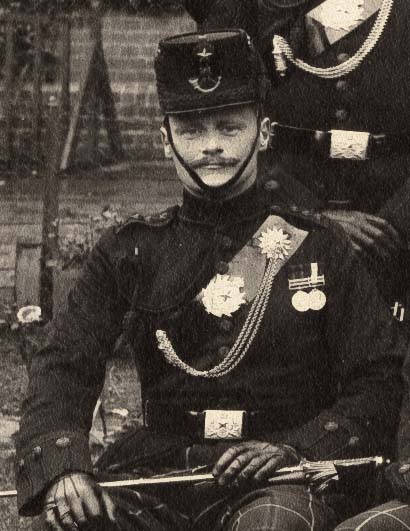
2nd Scottish Rifles in 1909
South Lanarkshire Council collection
The first introduction we got to our new Colonel came when all officers were summoned to the billiard room to be addressed by him. … He told us that the officer then commanding the 2nd Battalion in India had telegraphed suggesting that they might exchange commands. This appeared a natural thing to do as the other commander was a “1st Battalion man” and Uncle had spent most of his service with the 2nd Battalion. Uncle informed us that he had declined the offer as he was particularly anxious to serve with the 1st Battalion. …
When postings took place either to the Depot or the 2nd Battalion or elsewhere Uncle always sent the best of the NCOs, that is to say, only specialists were exempt … He never sent anyone away who, in his view, was sub-standard. … As time went on we discovered, often to our surprise, that the so-called ‘indispensables’ were more easily replaced than we had thought possible. Many years later I found it depressing to discover how disinclined many commanding officers were to let any of their best men go into circulation outside the Regiment. … Inevitably, where commanders are not prepared to take risks in peace they will never take them in war. …
To have served with Uncle for four years bred into us certain basic principles, and these were: the vital part that the Officers’ Mess plays in a battalion at all times; the acceptance by officers, individually and collectively, of full responsibility; a strong sense of justice, particularly in respect of the private soldier; an attention to detail, in so far as it affected the morale, efficiency and well-being of all ranks; and finally the need to meet squarely all demands made upon the Regiment from outside. …
All of this provided a grounding for officers and men alike, particularly in character-forming. There is a proverb to the effect that the shortest way there is the longest way round. This means that there are no worthwhile short cuts and that by going the long way there is no need to retrace one’s footsteps to make good shoddy or careless work. Uncle planted the roots so well that all aspects of regimental soldiering became second nature to us. I remember inspecting a cavalry regiment many years later and, passing through a barrack room, commented on what I saw. Some of these comments were complimentary and others quite critical. Staying on for lunch I was accosted by the Squadron Commander: “General, how did you do it? You did not miss anything.” I could only say: “It was not General Murray who took that inspection. It was the Lieutenant Murray of many years ago who gazed upon similar scenes too long to have to think about what was right and what was not.” …

The Cameronians (Scottish Rifles),
South Lanarkshire Council collection
… the Battalion thrived in many fields. Not the least of these was that during the twenty years which separated the two World Wars we had either a student or an instructor at one or other of the two Staff Colleges. …
The Regiment owed a great debt to those officers who had fought in the 1914/18 War and served on through the lean years with such ability and enthusiasm. In the 1st Battalion Uncle had the support of three officers who were staff trained: There was O’Connor who was Adjutant …; another was Riddell-Webster who was with us for nearly two years [as a company commander]; and the third was Evetts who served under Uncle for nearly a year. Another officer who should be mentioned … was Captain (later Brigadier) ACL [Chris] Stanley Clarke DSO [one of O’Connor’s closest friends][67] who was a company officer at Sandhurst from 1922 to 1925 and who directed a powerful flow of cadets into the Regiment. …
Reference has already been made to Murray’s comments on O’Connor – those of a very junior subaltern on an Adjutant who had not only already been Adjutant of the other Battalion but had commanded a battalion (2nd/1st HAC) with distinction in war. Further: O’Connor was one of the most highly decorated officers and already a legend; more than that:
[In January 1924] O’Connor received an offer of promotion to substantive major in a vacancy in the Seaforth Highlanders. Although this accelerated promotion into another regiment would have helped him in his career as well as being financially beneficial, he turned it down, preferring to remain with his own regiment. By chance, three days later, there came a posting order detailing him for a job in the War Office as a GSO 2 [a major’s appointment]. This appointment he resisted, as he was very anxious to return to regimental duty [he was on the staff of a brigade in Aldershot]. He was urgently needed back in the Regiment to help the new commanding officer of the 1st Battalion. … which was in drastic need of pulling together.[68]
O’Connor’s tour as Adjutant lasted just ten months – sufficient to see the Battalion well on its way to recovery. After that he joined his friend Stanley Clarke at Sandhurst. Succeeding him as Adjutant came Galloway. Let Sixsmith take up the tale:[69]
As an example of the attitude of the best officers who returned from the war, the author may cite the example of his own regiment. The senior officers had all had the experience of going to war in 1914 as part of a well-trained unit which had quickly proved itself in battle. But they were conscious that they had not been taught to look deeply into the problems of war and to think out the new methods that would be necessary. They were determined that they would bring up a generation which were not only good regimental officers but would also know something of the business of war. Every officer that became adjutant between 1923 and the beginning of the [Second World] war, except one, reached general’s rank. The exception, after distinguished service in command of a brigade in North West Europe, retired and became editor of the Army Quarterly. [Though not named here, this is none other than Brigadier CN Barclay CBE DSO, author of the history mentioned earlier and quoted at length. A footnote goes on to list the Adjutants in order of their appointment: O’Connor, Galloway, Graham, Barclay, Murray, Sixsmith himself, Collingwood and Alexander.]
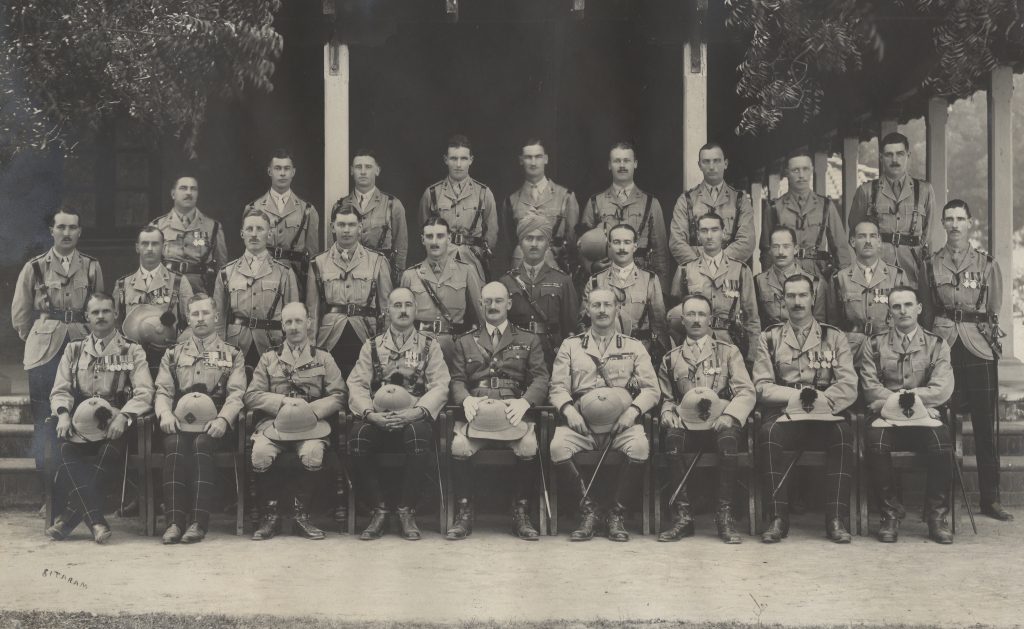
O’Connor (2nd left, front row), Money (4th left, front row), Sixsmith (3rd left, rear row),
Collingwood (3rd right, rear row) and Murray (1st right, front row)
South Lanarkshire Council collection
The point about this is not just that each of the generals in turn was good enough to fill this vitally important post, it is that each in turn was given his chance and brought on as a result. Of course the credit should go principally to the individuals, to their intelligence, industry and professionalism, but it should also go to the Commanding Officers who encouraged and promoted them. It is also worth noting that they were all adjutants of and therefore the product ultimately of the 1st Battalion, the old 26th. This should be contrasted with the distinguished senior officers pre-1881 who, as we have seen earlier, almost without exception came from the 90th.
The post of adjutant has already been referred to. It is in many ways unlike any other and in one way in particular: there is no training for it. It is usually the first opportunity that most regimental officers have to sit behind a desk, to deal with paper en masse, and the first opportunity to operate at battalion as opposed to platoon or company level. There is seldom any lengthy period for taking over. Having made his choice it is up to the Commanding Officer to see that his Adjutant receives the training in post which he needs and deserves. If the tyro staff officer is fortunate, his Colonel will be staff trained himself and may even have been an instructor at Staff College. So the classic route for someone advancing up the inside track would be: Adjutant – Staff College – Company Commander – Staff Appointment – OC Regimental Depot – Commanding Officer. Several of the pride of the ‘20’s did just that. At Figure 1 their progress can be followed with ease.
| Appointment | 1930 | 1931 | 1932 | 1933 | 1934 |
| OC Regimental Depot | Maj John Evetts MC 1930-32 | Maj Douglas Graham MC 1932-1935 | |||
| Commanding Officer 1st Battalion | Lt Col HC Hyde-Smith DSO 1927-30 | Lt Col Robin Money MC 1931-34 | Lt Col RD Hunter DSO 1934-35 | ||
| Adjutant 1st Battalion | Lt Horatius Murray 1930-33 | Lt Eric Sixsmith 1933-35 | |||
| Commanding Officer 2nd Battalion | Lt Col Thomas Riddell-Webster DSO 1930-33 | Lt Col RMS Baynes 1933-37 | |||
| Adjutant 2nd Battalion | Capt RA Anderson 1926-30 | Lt[1] RM Villiers 1931-34 | Lt HM Fisher 1934-36 |
[1] Later Brigadier DSO
| Appointment | 1935 | 1936 | 1937 | 1938 | 1939 |
| OC Regimental Depot | Maj[1] Alexander Galloway MC 1935-37 | Maj[2] DF Campbell MC 1937-39 | Lt Col RD Hunter DSO 1939-41 | ||
| Commanding Officer 1st Battalion | [3] Lt Col[4] CF Drew DSO 1936-38 | Lt Col Alexander Galloway MC 1938-39 | |||
| Adjutant 1st Battalion | Lt[5] George Collingwood 1936-38 | Lt Henry Alexander 1938-39 | Lt[6] DG Jebb 1939 – | ||
| Commanding Officer 2nd Battalion | Lt Col Douglas Graham MC 1937-40 | ||||
| Adjutant 2nd Battalion | Capt AJ Lardner-Clark 1936-38 | Capt JEB Whitehead 1938-39 | Lt JH Law 1939-40 |
Copyright © 2005 Philip R Grant (prgblue@yahoo.com)
All rights reserved.
[1] Brevet Lt Col
[2] Later Brigadier
[3] Lt Col Richard O’Connor DSO* MC was nominated to command but was instead promoted to Command the Pershawar Brigade
[4] Later Brigadier
[5] Captain from April 1936
[6] Later Brigadier CBE DSO*
So we already have a system which is nurturing its own and bringing them on. Those not fortunate enough to benefit from a system like this will, at this stage cry, “Old Boys’ Network! Old School / Regimental Tie! Black (Button) Mafia! Favouritism! Nepotism!” Would they be justified? To a degree, but only to this extent: that if an individual is unworthy of the confidence shown by selection he will soon be found out and will advance no further. As they say in business, nothing kills a bad product faster than good advertising. But if the individuals are of talent, have been well trained and are well qualified for their jobs then the criticism is unjustified and can be put down to envy, malice and all uncharitableness, all of which, after all, are very human weaknesses. This is especially true when criticism comes from outside the Regiment, as it invariably does, and to it can be added ignorance.
We should not pass on without a footnote to that too. It is said that an officer’s annual confidential report says as much about the reporting officer (the writer) as it does about the subject. Any officer who promotes another above his ability will himself soon be the focus of criticism. Few would think that worth the risk.
There was another vital appointment and we return now to the role of the father of the Regiment. The Cameronians (Scottish Rifles) were particularly fortunate in the appointment in 1927 of a new Colonel of The Regiment who was to serve right through until handing over to Riddell-Webster in 1946 – an astonishingly long tenure, even allowing for six years of war. He was Major General Sir Eric Girdwood KBE CB CMG. According to Story: ‘It was his policy to knit the Regiment more closely together than ever …’ [70]To achieve this, amongst other things, he instituted the Regimental Committee: ‘… the purpose of which is to manage the affairs of the Regiment which are outside the scope of Battalion Commanders or the officer commanding the Depot …’. His influence in the selection of commanding officers should not be overlooked either. To see how well he succeeded one need only look at Figure 1 and the year 1931. The talent deployed then was truly extraordinary. Reading from the top of the table to the bottom: their eventual ranks were: Lieutenant General, Major General, General, General, and Brigadier.

(later the 15th Duke of Hamilton),
at Douglas, 14 May 1939,
South Lanarkshire Council collection
Girdwood was a Captain in 1914 and by the following year, still a Captain, he was a Brigade Major in France. By 1917, though still only a substantive Major, he had risen to the rank of Major General. He commanded the 74th Division at the Third Battle of Gaza that year. ‘The extraordinary speed of its advance had an immediate effect at Gaza, since the enemy had to withdraw and conform to a general retirement everywhere.’[71] It was this breadth of experience which was to stand him in such good stead and which had such a great and positive effect on the Regiment as a whole.
His appointment as Colonel coincided with that as Commandant of the RMC Sandhurst (1927-30). (This was just as O’Connor started his last term as an Instructor down the road at Camberley.) It was during Girdwood’s time at Sandhurst that Frost and Alexander were recruited to the Regiment. His last appointment was as GOC Northern Ireland. In 1937, for the Coronation of King George VI, he was appointed Gold Stick Staff Officer and as such had responsibility for all of the seating arrangements in Westminster Abbey. Notwithstanding all of his other duties, in war as in peace-time, he was assiduous in his attention to the welfare of ‘his’ Regiment: a true ‘father’. It was typical that he was on the quayside at Southampton when the 2nd Battalion sailed home from the Middle East on 30 December 1936.[72]
Barclay describes in detail the work over which Girdwood presided:
Apart from its more concrete peace-time activities – such as the Regimental Association and the Regimental Journal [The Covenanter] – the Regimental Committee had a very notable influence for good in what may be termed the more intangible affairs of the Regiment. In particular it exercised a marked, if indirect, influence on officers’ careers. It became a feature of Regimental policy to encourage young officers to enter one of the staff colleges, and to apply for attachment to Colonial forces – such as the King’s African Rifles and the West African Frontier Force. [Croft had served with the latter. In Frost’s case it was the Iraq Levies.] The Committee also interested themselves in the selection of suitable officers as Adjutants of Territorial battalions, the nomination of officers as instructors at the RMC Sandhurst, and a variety of similar appointments.[73]
So here one sees engaged not just the experienced, clever and devoted Commanding Officers but a whole high-voltage network. Murray again:
Throughout all these years ran a strong thread of Regimental pride which stemmed from the years before the First World War and back into history and whose prophet was Uncle Ferrers. There was the breadth of view in respect of affairs and the Army as a whole made possible by an outward-looking Regimental policy. There was the determination to meet all challenges from whatever quarters as they presented themselves.
But what he then goes on to say is of equal importance.
Nevertheless these things might not have led to such a rich harvest had it not been for the outbreak of the Second World War, when opportunities for advancement abounded.
Much turns in military careers on the ability to be in the right place at the right time. Here we have a pride of lions all of whom have been groomed and who are ready to pounce on the opportunities on which their minds have been focusing for their whole careers. There seems little doubt that Riddell-Webster and O’Connor were both assiduous in keeping close by them a selection of the best. Why not? They had known them all of their regimental lives, they had trained them, groomed them, encouraged them and watched them grow into their various appointments. When the time came, why would they look further? It was not preferment for the sake of those chosen; it was for the mutual benefit of the chosen and the chooser and for those below them. Each in turn was allowed his opportunity to shine.
So it was that when O’Connor took command of 7th Division in Palestine, taking Collingwood with him, Evetts was already a Brigade Commander there. And when O’Connor went on to command the Desert Force (the equivalent of a corps) we find Evetts as GOC 6 Division and Galloway becomes BGS British Troops Egypt. But then, as O’Connor disappears to prison camp, so Evetts is transferred to the War Office where his time on the ‘Q’ side almost exactly coincides with Riddell-Webster. Is it conceivable that the latter did not connive at this? One doubts it. And who better to help the way, dealing with the deployment of formations as Director Staff Duties, but Galloway, kidnapped on his way back to the Middle East from a trip to the States. Not long after Galloway left the SD Branch we find Sixsmith there as its Deputy Director.
Back in the Middle East as Deputy Chief of Staff we now have Haugh, as well as Graham commanding a division.[74] As soon as the campaign is over in North Africa, Haugh is hauled back to London. Where? To be Deputy Quartermaster General under Riddell-Webster. And Graham? He is now commanding a division in North West Europe where O’Connor is a corps commander. Finally, after the war, when O’Connor is to be shunted back to the War Office, who takes over Eastern District in India? It’s none other than Bucher who pops up. Does one suppose that Sixsmith did not have at least a small hand in that as well? So the high-voltage grid goes on energising each theatre of war and drawing on all that training and professionalism which the World War I veterans were so keen to pass on. Only the naïve would think all of this a happy coincidence and only conspiracy theorists would think it was anything other than the proper use of the undoubted talents available.
Barclay in his appreciation of Riddell-Webster remarks on the ‘penchant’ of senior officers for either command or staff and comes down, for Riddell-Webster, in the middle. In doing so he seems to want it both ways. Any reader of these short biographical notes will have concluded that, whatever success Riddell-Webster had in command, there is no doubt that his greatest contribution was as a staff officer. It must be assumed that this was the view of his superiors too, no matter how few in number they were. It must also be self-evident that O’Connor was an outstanding commander. Yes, he held important staff positions, but considering his career in the round there is no doubt that he will be remembered as a commander. It seems therefore that The Generals divided themselves as follows:
Commanders: O’Connor, Murray, Collingwood, Graham, Frost, and Bucher.
Staff Officers: Riddell-Webster, Evetts, Sixsmith, Haugh.
A Bit of Both: Galloway, Money, Alexander, though all lean heavily towards command.
It would be hard to find a better-balanced pride of Generals.
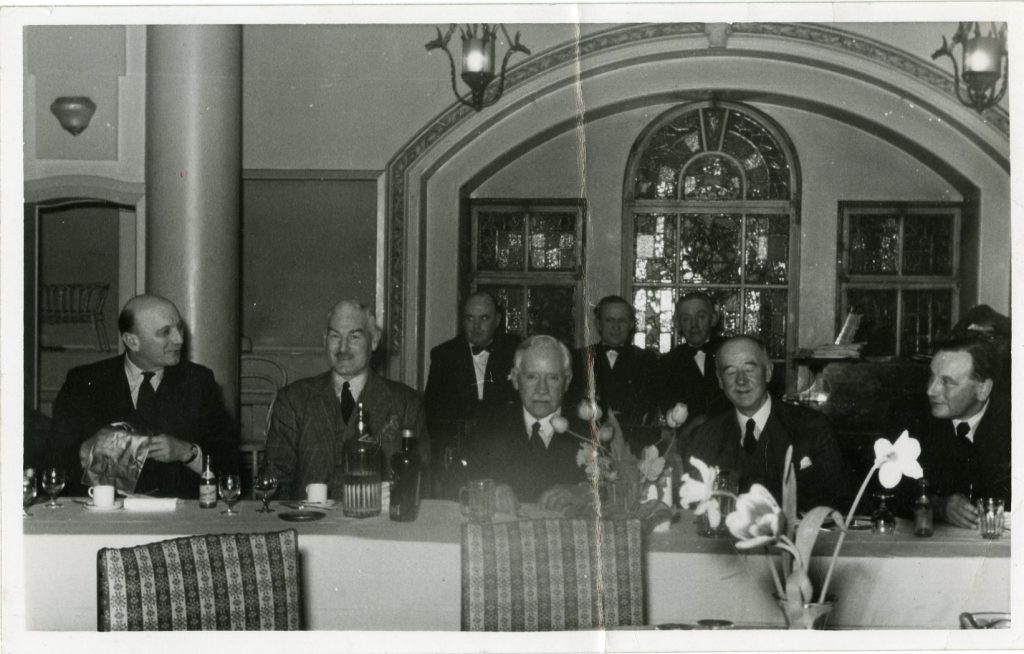
at a Cameronian Officers Dinner, Glasgow, March 1954
South Lanarkshire Council collection
Now would be a good time to remind ourselves that The Generals were not the only officers of the Regiment to succeed. Many others distinguished themselves in both World Wars; none more so than the seventeen Brigadiers who were shown to have grown from the same culture. (Barclay lists nineteen in 1947, but there were inevitably changes over the following twenty years.) Taken together, as Murray does, the 1968 record of thirteen Generals and seventeen Brigadiers seems unlikely to have been surpassed at any time in the history of the British Army. The point here however is to highlight that The Generals were not just a thin layer of icing, cream or froth which floated to the top. There was real strength in depth. The talent ran all the way down through the whole of the Regiment.
Which brings us to the men of the Regiment: it is beyond doubt that all of the senior officers, led by the generals, would have at every turn and on every occasion paid tribute to the great strengths of the men of all ranks who gave the Regiment its reputation as second to none. They were, for the most part, Lowland Scots: their comradeship, their humour, their talent for defiance in the face adversity, all carry the unmistakeable stamp of their origins. The great Lieutenant General WJ (Bill) Slim (later Field Marshal Viscount Slim) wrote to the then Commanding Officer, in a letter to be found in the Regimental Museum[75]:
The retreat from Burma in 1942 was as severe an ordeal as any army could be called upon to endure but the British and Indian units of the Burma Corps, fighting, falling back, and turning to fight again and again, lived up to the great traditions of their services. Unsurpassed among them in stubborn courage and in that unquenchable spirit, which lifts men above fatigue and disaster and is the essence of a Regiment, was the 1st Battalion The Cameronians.
Battered, exhausted, hungry, reduced by casualties to a fraction of their strength, they never lost their fighting spirit or their indomitable cheerfulness. Whether they were six hundred or one hundred, they were always the 1st Battalion The Cameronians.[76]
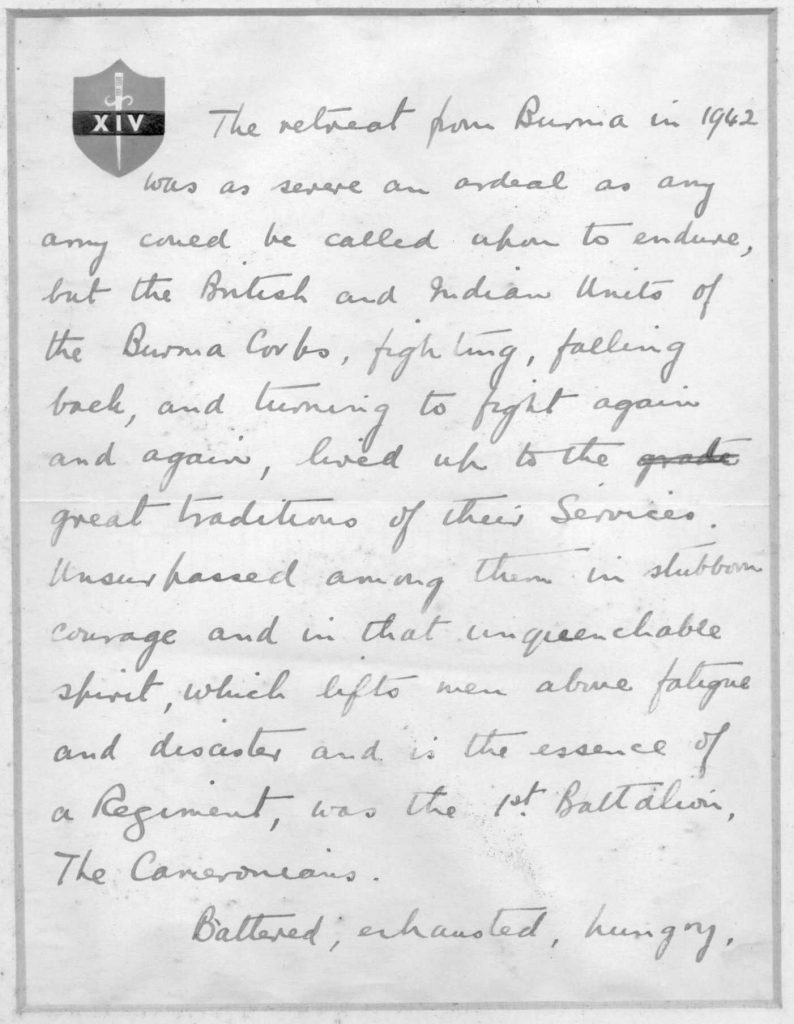
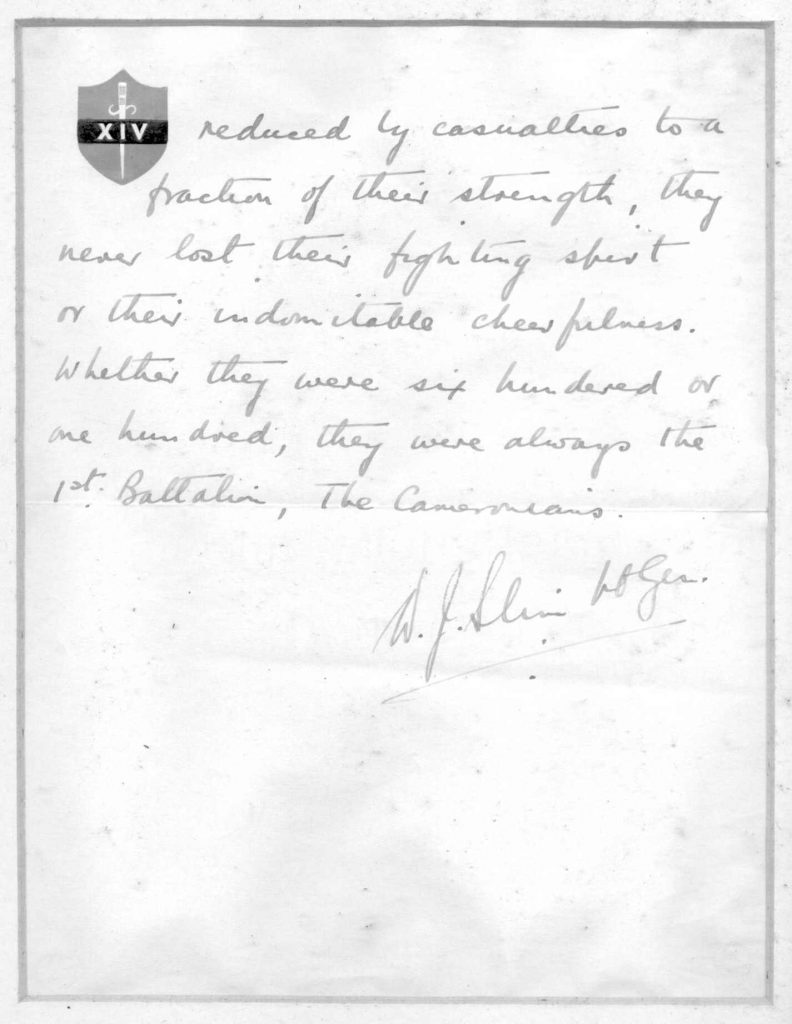
South Lanarkshire Council collection
‘Stubborn courage and …unquenchable spirit…’ here were the true inheritors and direct descendants of the Covenanters who had so distinguished themselves at the Battle of Dunkeld only weeks after the Regiment was founded in 1689.Until the 1950’s each man was still issued with a bible, complete with Regimental crest on its cover, a tradition carried on from these Covenanting days. It would be fair to say, however, that not all of them spent their leisure time in scripture study. They were hard and needed firm handling, but not a single officer who ever had the privilege of leading them would ever have swapped them. They too were part of the training and upbringing which helped to forge the lives and careers of The Generals.
So there we have it then: a regiment of superb fighting soldiers who deserved the best leadership. We have an officer corps with a long tradition of service, devotion to duty, commitment. There is a tradition of producing fine leaders and outstanding generals. Above all, there was the will and the wish to move on, to learn the lessons of the Great War and to strive for a new level of professionalism unheard of in the pre-war army. Best of all here was a pride of fine young men who all happened to come together over the same period (and at the right time) and who were to create a unique record of distinction.
At the Disbandment Parade on 14 May 1968 the minds of all of the Regiment still serving, though conscious of the past, were focused almost entirely on the future. They could never have understood, let alone appreciated, that the thoughts of all of the Old and Bold were entirely on the past. What memories they all had. None more so than those who had joined the Regiment as much as sixty years before. What were their thoughts? For sure they looked with pride at the young men on parade and were pleased with what they saw. Even when it came to disbanding there was only one way of doing things.
The last operational tour of the 1st Battalion was in Aden and South Arabia. During its stay there they were visited by their Colonel, ‘The Wicked Uncle’. Of his visit he wrote a full account in The Covenanter. It finished:
And so ended a wonderful experience for an elderly and retired soldier to have been able to live with the Regiment for a short space in semi-operational camp … It was rather like a ghost coming back to his family home after thirty years to see what was going on and retiring again with a happy sigh to find that the old home was in good hands and the old traditions going on just as before.[77]
This then was the tradition, the heritage. The old ghost was always there, be he a ‘Daddy’ or a ‘Wicked Uncle’, or a Tom, a Dick or a Henry. There was only one way that things were done. It was the way inculcated by ‘Uncle’, ‘PR’ and ‘Nap’. It was the way of The Cameronians (Scottish Rifles) who were a unique part of Scottish history for over three hundred years.
Almost the last words heard at the Disbandment were those of a much-loved former Chaplain to both regular battalions who gave the final address. He closed with the words:
“… So put pride in your step Cameronians! As you march out of the Army List, you are marching into history, and from your proud place there, no man can remove your name, and no man can snatch a rose from the chaplet of your honour.”
The achievements of The Generals adorned that crown. They were a unique group; the product of a unique regiment. We shall never see their like again, nor such a regiment.
Copyright
Copyright © 2005 and 2021, Philip R Grant (prgblue @ yahoo.com)
All rights reserved.
The copyright of all of the authors and publishers named is acknowledged. Every effort has been made to trace all of the copyright holders. Even where this has not been achieved their contribution is noted with gratitude.
The author is greatly indebted to Barrie Duncan and the staff at Low Parks Museum, keepers of the Cameronian Archives, for assistance with the publication of this piece and especially for all of the excellent illustrations which were absent from the original published article
Publisher
First published by The Trustees of The Cameronians (Scottish Rifles) as a supplement to the 2005 edition of the regimental magazine, The Covenanter. All rights reserved. Any part of this article may be reproduced provided that the author and publishers are acknowledged.
[1] The History of The Cameronians (Scottish Rifles) Volume IV p 199
[2] Facsimile copy formerly in the author’s possession, now in the Regimental archives
[3] Facsimile copy formerly in the author’s possession, now in the Regimental archives
[4] By Lt Col Sir John Baynes Bt, published by Cassell in 1971 p 206
[5] Ibid
[6] Ibid p 211
[7] Published by Sifton Praed, p 249
[8] The History of The Cameronians (Scottish Rifles) Volume IV p 211
[9] One of Wellington’s biographers has said this. It is certainly fair to say he was one of the ablest. He was nominated to succeed the Iron Duke had he fallen.
[10] He succeeded Wellington and was Commander-in-Chief, 1828-42.
[11] By Professor SHF Johnston and published by Gale & Polden Ltd in 1957
[12] The rank of Rifleman was not adopted in the Regiment until 1923
[13] The History of The Cameronians (Scottish Rifles) Volume III p 13
[14] A Gaggle of Generals, The Covenanter, Winter 1972
[15] Winter 1974
[16] It is the convention in the Army List to use a * to denote that a bar was awarded to a DSO or MC (or indeed for the VC), in other words that the award was made more than once, each * denoting a separate award (or bar).
[17] 1981
[18] Published in 1989 by Brassey’s (UK)
[19] ©The Times dated 19 Jun 81. Quoted in The Covenanter of 1981
[20] The Forgotten Victor p 259
[21] Ibid p 34
[22] Correlli Barnett © Sunday Times 21Jun 81. Quoted in The Covenanter of 1981
[23] His official army record (AFB 199) gives his height as 5’6⅛” the final fraction having been added later and in another hand. Is it possible that he was a little self-conscious of his height and had taken the opportunity to set the record straight himself?
[24] See note 37 below
[25] 6 July 1989
[26] 1989. It also says that ‘…he played for the army in gaol.’ (sic). He may not have been the first (or the last) of his regiment to have done so!
[27] It is one of these strange coincidences that this regiment was also commanded by another Cameronian. On the disbandment of the 1st Battalion in 1968 Captain George McL Stephen transferred to The Royal Scots Greys. Given command of the 13th/18th, Lieutenant Colonel Stephen (as he became) was the only ex-Cameronian who went on to command a regular regiment.
[28] The Times 24 December 1988
[29] See British Generalship in The Twentieth Century by Maj Gen Eric Sixsmith, published by Arms and Armour Press, 1970, p 173
[30] Summer 1977
[31] Letter to the author, 18 April 2006
[32] A word of caution though: officers’ extra-regimental careers are managed by the department of the Military Secretary. His staff will of course liaise closely with the staff of the Director of Staff Duties whose principal function is the deployment of units and formations.
[33] From an appendix in A Biography of Field Marshal Sir Claude Auchinleck by John Connell, Cassell, 1959
[34] The Forgotten Victor p 47
[35] In a pen-portrait of Jack by Money which forms a preface to General Jack’s Diary
[36] The 2nd Battalion suffered dreadful casualties. The only survivors – 150 other ranks – were led out of battle by 2nd Lieutenant Somervail and Regimental Sergeant Major Chalmers. 13 officers (including the Commanding Officer and his Adjutant) and 112 Other Ranks had been killed; nine officers and 314 Other Ranks had been wounded. Included in these figures were 29 sergeants and lance-sergeants either killed or wounded. (See Volume II of the Regimental History pp38-49.) See also Morale by Lt Col Sir John Baynes (Cassell 1967).
[37] Winter 1971
[38] His successor commanding 153 Brigade from 25 May 43 was ‘Nap’ Murray (see above), no doubt on Graham’s recommendation.
[39] Winter 1969
[40] Published by Arms and Armour Press 1970
[41] The Times dated 22 May 1993
[42] 1993
[43] Winter 1977. © The Times
[44] African Tightrope published by Pall Mall Press in 1965
[45] The Covenanter, September 1965
[46] The Covenanter, Winter 1974
[47] Published in The Covenanter of Winter 1972
[48] The Forgotten Victor p 5
[49] Hazel Watson & Viney Ltd, 1961
[50] Economic History Services website (adjusted and rounded)
[51] The Forgotten Victor p 7
[52] Major General J Bruce-Scott, quoted in Volume III of The Regimental History p 97
[53] Published by Hutchinson in 1966
[54] The Covenanter, September 1965
[55] The Covenanter, September 1968
[56] British Generalship in the Twentieth Century p 167
[57] Ibid p 27
[58] History of The Cameronians (Scottish Rifles) Volume II pp 392-404
[59] General Jack’s Diary 1914-1918, published by Eyre & Spottiswoode in 1964
[60] An Appreciation of John Terraine by Lt Col Sir John Baynes in The Covenanter, 2004
[61] September 1968
[62] It has since come to light that his obituary is wrong. It was the end of 1916, by which time he was a Major and had been Adjutant for four years. See the History of the 5th Battalion (5SR).
[63] In 1914 all of the seven adjutants were Captains. What is noticeable about those who were Adjutant of the 1st Battalion during the period 1930-40 is that they were all subalterns on appointment. In other words: there was a deliberate policy of bringing on the best of the young officers as soon as possible. (See Figure 1.)
[64] He was killed in early 1915, shortly before the Battle of Neuve Chapelle. See Morale by John Baynes, Cassell 1967 Appendix B.
[65] He served for the unusually long period of four years from January 1913 to December 1916. He left an indelible mark on a remarkable battalion.
[66] A Gaggle of Generals, The Covenanter, Winter 1972
[67] The Forgotten Victor, p 34
[68] Ibid, p 31
[69] British Generalship in Twentieth Century p 170
[70] Regimental History Volume II p 387
[71] Ibid, p 222
[72] Ibid, p 25
[73] Ibid, p 15
[74] See notes 24 and 37 above. It is almost inconceivable that Graham did not recommend Murray as his successor in command of 153 Brigade.
[75] The Regimental Collection is now held at the Low Parks Museum, Hamilton, South Lanarkshire.
[76] In another letter of 10 May 1968 Slim wrote to the Colonel of The Regiment: ‘I am more sorry than I can say, to have to miss saying goodbye to a Regiment I have served alongside … and which has always earned my highest respect. … give my warmest respects and good wishes to all Cameronians at the [Disbandment] Parade and tell them that had it been possible, I would have been with them. (The Covenanter, June 1968)
[77] Volume XLV (1967) p 118
Comments: 2
